Paul van Yperen's Blog, page 144
October 27, 2021
Evelyn Keyes
Evelyn Keyes (1916-2008) was an American film actress. She is best known for her role as Suellen O'Hara in Gone with the Wind (1939) and for the female lead in the blockbuster hit The Jolson Story (1946). Her final film was The Seven Year's Itch (1955) starring Marilyn Monroe.
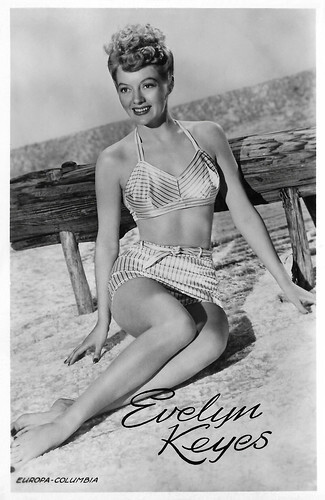
Dutch postcard, no. 3199. Photo: Europa Columbia.

British postcard in the Picturegoer Series, London, no. W. 264. Photo: Columbia.
Scarlett's whiny, bratty sister
Evelyn Louise Keyes was born in Port Arthur, Texas, in 1916, to Omar Dow Keyes and Maude Ollive Keyes, the daughter of a Methodist minister. After Omar Keyes died when Evelyn was two or three years old (the sources differ). Keyes moved with her mother, her only brother, and her three sisters to Atlanta, Georgia, where they lived with her grandparents.
As a teenager, Keyes took voice, piano, and dancing lessons. She was hopeful of becoming a ballerina. Instead, Evelyn performed for local clubs such as the Daughters of the Confederacy and entered beauty pageants. A chorus girl by age 18, Keyes moved to Hollywood and was introduced to director Cecil B. DeMille who in her own words “signed me to a personal contract without even making a test”.
She was groomed as a starlet and initially placed in bit roles. De Mille first gave her a small part in his pirate epic The Buccaneer (Cecil B. DeMille, 1938) starring Fredric March , then placed her in his sprawling railroad saga Union Pacific (Cecil B. DeMille, 1939). After a handful of B movies at Paramount Pictures, she landed a minor role in Gone with the Wind (Victor Fleming, 1939), that of Scarlett O'Hara's sister, the whiny, bratty Suellen, who loses her beau to the more calculating Scarlett.
This led directly to her signing with Columbia Pictures. In 1938, just prior to the filming of GWTW, she married businessman Barton Bainbridge, her first of four. The marriage soured within a year or so, however, after she took up with Budapest-born director Charles Vidor. Bainbridge committed suicide by gunshot during the final separation period. Charles Vidor directed three of her pictures: The Lady in Question (1940) - her first at Columbia, Ladies in Retirement (1941), and The Desperadoes (1943). This second marriage lasted about as long as the first (1943-1945), supposedly due to Vidor's infidelities.
At Columbia, Evelyn hit pin-up status and sparked a number of war-era pictures. She played Boris Karloff's daughter in the crime horror Before I Hang (Nick Grinde, 1940) and a blind woman who befriends the hideously scarred Peter Lorre in the excellent The Face Behind the Mask (Robert Florey, 1941). She also played an ingenue in Here Comes Mr. Jordan (Alexander Hall, 1941) with Robert Montgomery. Gary Brumburgh at IMDb : "No shrinking violet this one, but despite her talent, vivacity and sheer drive, lovely and alluring blonde Evelyn Keyes would remain for the most part typed as a "B" girl on the silver screen."
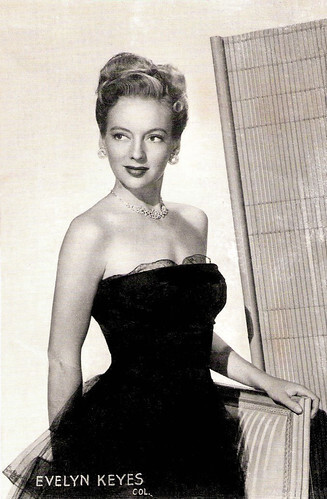
Vintage postcard. Photo: Columbia.

British postcard by Real Photographs Co., Ltd, Southport. Caption: Evelyn Keyes, vivacious blonde beauty in Columbia Pictures, has an impressive credit list of appearances in The Jolson Story, The Thrill of Brazil, Renegades, A Thousand and One Nights, and many others. Married to Hollywood writer-director John Huston, she comes from Georgia.
Tom Ewell's vacationing wife
Evelyn Keyes spent most of the early 1940s playing leads in many of Columbia's B dramas and mysteries. In the post-war years, a third tempestuous but highly adventurous marriage (1946-1950) to John Huston made the tabloid papers practically on a weekly basis. They divorced after four years.
She did some of her best work during this period. Keyes appeared as the female lead opposite Larry Parks in Columbia's blockbuster hit The Jolson Story (Alfred E. Green, 1946). She followed this up with an enjoyable minor screwball comedy, The Mating of Millie (Henry Levin, 1948), with Glenn Ford . She was then Kathy Flannigan in Mrs. Mike (Louis King, 1949).
Keyes' last role in a major film was a small part as Tom Ewell's vacationing wife in The Seven Year Itch (Billy Wilder, 1955), which starred Marilyn Monroe . Keyes officially retired in 1956, but she continued to act. She married bandleader Artie Shaw (1957–1985). Keyes said of her many relationships: "I always took up with the man of the moment and there were many such moments." While married to Huston, the couple adopted a Mexican child, Pablo, whom Huston had discovered while on the set of The Treasure of the Sierra Madre.
Very much the traveler, Evelyn lived sporadically all over the world, including France, England, and Mexico, and spoke Spanish and French fluently. Evelyn returned to the acting fold every once in a while. She joined up with Don Ameche in a 1972 tour of the musical 'No, No, Nanette' and also would show up on an episode of The Love Boat (1977) or Murder, She Wrote (1984) every now and then.
In 1977 she published her autobiography 'Scarlett O'Hara's Younger Sister: My Lively Life In and Out of Hollywood'. Wikipedia : "Keyes expressed her opinion that Mrs. Mike was her best film. She also wrote of the personal cost she paid by having an abortion just before Gone with the Wind was to begin filming, as the experience left her unable to have children." Among the many Hollywood affairs, Keyes recounted in 'Scarlett O'Hara's Younger Sister' were those with Glenn Ford , Sterling Hayden, Dick Powell , Anthony Quinn , David Niven , and Kirk Douglas .
She also became involved with flamboyant producer Mike Todd for three years during his preparation and filming of Around the World in 80 Days (Michael Anderson, 1956). She even played a cameo role in the movie and helped with publicity. During the filming, he broke things off after falling in love with Elizabeth Taylor , whom he later married. The positive thing that came out of it for her was that she had invested most of her money in the picture and was financially set for life as a result.
In 2005, she sued Artie Shaw's estate, claiming that she was entitled to one-half of Shaw's estate pursuant to a contract to make a will between them. Shaw died in 2004. In July 2006, a Ventura, California jury unanimously held that Keyes was entitled to almost one-half of Shaw's estate, or $1,420,000.
Evelyn Keyes died in 2008 from uterine cancer at the Pepper Estates, an assisted-living residence in Montecito, California. She was 91. She was cremated with her ashes being divided among her relatives with the remaining half sent to Lamar University in Port Arthur, Texas, and the last of the cremated remains being buried with her relatives in the family plot at The Waco Baptist Church Cemetery, Waco, Georgia, with a small tombstone with the epitaph 'Gone with the Wind', where her ashes were buried in 2008.
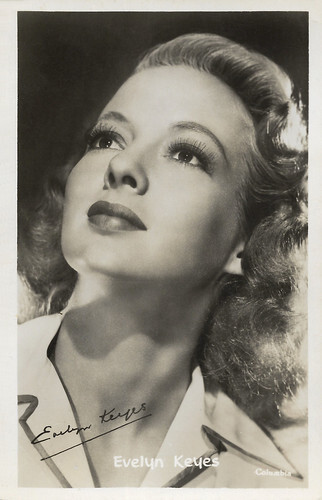
Vintage card. Photo: Columbia.
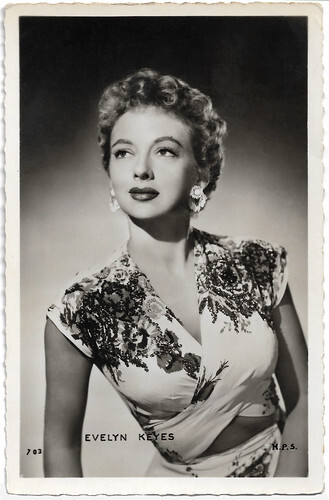
French postcard by Editions P.I., Paris, no. 703. Photo: H.P.S.
Sources: (IMDb), Find A Grave, Wikipedia, and .

Dutch postcard, no. 3199. Photo: Europa Columbia.

British postcard in the Picturegoer Series, London, no. W. 264. Photo: Columbia.
Scarlett's whiny, bratty sister
Evelyn Louise Keyes was born in Port Arthur, Texas, in 1916, to Omar Dow Keyes and Maude Ollive Keyes, the daughter of a Methodist minister. After Omar Keyes died when Evelyn was two or three years old (the sources differ). Keyes moved with her mother, her only brother, and her three sisters to Atlanta, Georgia, where they lived with her grandparents.
As a teenager, Keyes took voice, piano, and dancing lessons. She was hopeful of becoming a ballerina. Instead, Evelyn performed for local clubs such as the Daughters of the Confederacy and entered beauty pageants. A chorus girl by age 18, Keyes moved to Hollywood and was introduced to director Cecil B. DeMille who in her own words “signed me to a personal contract without even making a test”.
She was groomed as a starlet and initially placed in bit roles. De Mille first gave her a small part in his pirate epic The Buccaneer (Cecil B. DeMille, 1938) starring Fredric March , then placed her in his sprawling railroad saga Union Pacific (Cecil B. DeMille, 1939). After a handful of B movies at Paramount Pictures, she landed a minor role in Gone with the Wind (Victor Fleming, 1939), that of Scarlett O'Hara's sister, the whiny, bratty Suellen, who loses her beau to the more calculating Scarlett.
This led directly to her signing with Columbia Pictures. In 1938, just prior to the filming of GWTW, she married businessman Barton Bainbridge, her first of four. The marriage soured within a year or so, however, after she took up with Budapest-born director Charles Vidor. Bainbridge committed suicide by gunshot during the final separation period. Charles Vidor directed three of her pictures: The Lady in Question (1940) - her first at Columbia, Ladies in Retirement (1941), and The Desperadoes (1943). This second marriage lasted about as long as the first (1943-1945), supposedly due to Vidor's infidelities.
At Columbia, Evelyn hit pin-up status and sparked a number of war-era pictures. She played Boris Karloff's daughter in the crime horror Before I Hang (Nick Grinde, 1940) and a blind woman who befriends the hideously scarred Peter Lorre in the excellent The Face Behind the Mask (Robert Florey, 1941). She also played an ingenue in Here Comes Mr. Jordan (Alexander Hall, 1941) with Robert Montgomery. Gary Brumburgh at IMDb : "No shrinking violet this one, but despite her talent, vivacity and sheer drive, lovely and alluring blonde Evelyn Keyes would remain for the most part typed as a "B" girl on the silver screen."

Vintage postcard. Photo: Columbia.

British postcard by Real Photographs Co., Ltd, Southport. Caption: Evelyn Keyes, vivacious blonde beauty in Columbia Pictures, has an impressive credit list of appearances in The Jolson Story, The Thrill of Brazil, Renegades, A Thousand and One Nights, and many others. Married to Hollywood writer-director John Huston, she comes from Georgia.
Tom Ewell's vacationing wife
Evelyn Keyes spent most of the early 1940s playing leads in many of Columbia's B dramas and mysteries. In the post-war years, a third tempestuous but highly adventurous marriage (1946-1950) to John Huston made the tabloid papers practically on a weekly basis. They divorced after four years.
She did some of her best work during this period. Keyes appeared as the female lead opposite Larry Parks in Columbia's blockbuster hit The Jolson Story (Alfred E. Green, 1946). She followed this up with an enjoyable minor screwball comedy, The Mating of Millie (Henry Levin, 1948), with Glenn Ford . She was then Kathy Flannigan in Mrs. Mike (Louis King, 1949).
Keyes' last role in a major film was a small part as Tom Ewell's vacationing wife in The Seven Year Itch (Billy Wilder, 1955), which starred Marilyn Monroe . Keyes officially retired in 1956, but she continued to act. She married bandleader Artie Shaw (1957–1985). Keyes said of her many relationships: "I always took up with the man of the moment and there were many such moments." While married to Huston, the couple adopted a Mexican child, Pablo, whom Huston had discovered while on the set of The Treasure of the Sierra Madre.
Very much the traveler, Evelyn lived sporadically all over the world, including France, England, and Mexico, and spoke Spanish and French fluently. Evelyn returned to the acting fold every once in a while. She joined up with Don Ameche in a 1972 tour of the musical 'No, No, Nanette' and also would show up on an episode of The Love Boat (1977) or Murder, She Wrote (1984) every now and then.
In 1977 she published her autobiography 'Scarlett O'Hara's Younger Sister: My Lively Life In and Out of Hollywood'. Wikipedia : "Keyes expressed her opinion that Mrs. Mike was her best film. She also wrote of the personal cost she paid by having an abortion just before Gone with the Wind was to begin filming, as the experience left her unable to have children." Among the many Hollywood affairs, Keyes recounted in 'Scarlett O'Hara's Younger Sister' were those with Glenn Ford , Sterling Hayden, Dick Powell , Anthony Quinn , David Niven , and Kirk Douglas .
She also became involved with flamboyant producer Mike Todd for three years during his preparation and filming of Around the World in 80 Days (Michael Anderson, 1956). She even played a cameo role in the movie and helped with publicity. During the filming, he broke things off after falling in love with Elizabeth Taylor , whom he later married. The positive thing that came out of it for her was that she had invested most of her money in the picture and was financially set for life as a result.
In 2005, she sued Artie Shaw's estate, claiming that she was entitled to one-half of Shaw's estate pursuant to a contract to make a will between them. Shaw died in 2004. In July 2006, a Ventura, California jury unanimously held that Keyes was entitled to almost one-half of Shaw's estate, or $1,420,000.
Evelyn Keyes died in 2008 from uterine cancer at the Pepper Estates, an assisted-living residence in Montecito, California. She was 91. She was cremated with her ashes being divided among her relatives with the remaining half sent to Lamar University in Port Arthur, Texas, and the last of the cremated remains being buried with her relatives in the family plot at The Waco Baptist Church Cemetery, Waco, Georgia, with a small tombstone with the epitaph 'Gone with the Wind', where her ashes were buried in 2008.

Vintage card. Photo: Columbia.

French postcard by Editions P.I., Paris, no. 703. Photo: H.P.S.
Sources: (IMDb), Find A Grave, Wikipedia, and .
Published on October 27, 2021 22:00
October 26, 2021
Peer Gynt (1919)
Henrik Ibsen's dramatic poem 'Peer Gynt' (1867) is one of the most widely performed Norwegian plays and was adapted many times for stage and screen. Peer Gynt (Victor Barnowsky, 1919) was a two-part silent film produced by Richard-Oswald-Film. It consists of Part 1: Peer Gynts Jugend/Peer Gynt's Youth and Part 2: Peer Gynts Wanderjahre und Tod/Peer Gynt's Wandering Years and Death. It was the only film directed by theatre expert Barnowsky, who also scripted the film. The cinematography was by Max Fassbender. Heinz Salfner played Peer Gynt and Ilka Grüning - in her film debut - played his mother Aase.
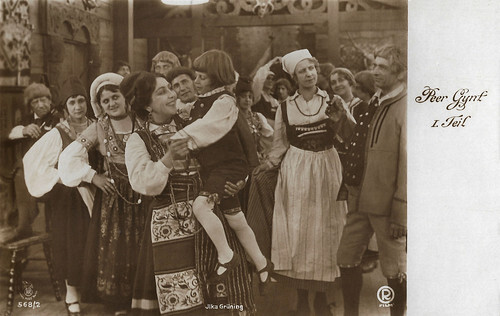
German postcard in the Film-Sterne series by Rotophot, no. 568/2. Photo: Richard Oswald-Film. Ilka Grüning as Aase in Peer Gynt (Victor Barnowsky, 1919).
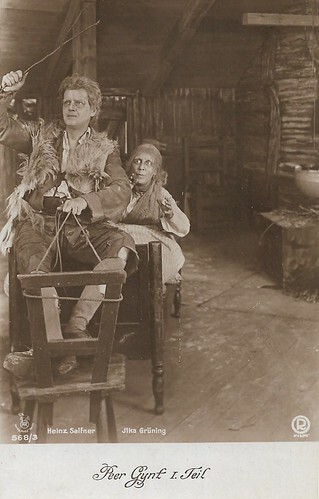
German postcard in the Film Sterne series by Rotophot, no. 568/3. Photo: Richard Oswald-Film. Heinz Salfner as Peer Gynt and Ilka Grüning as his mother Aase in Peer Gynt (Victor Barnowsky, 1919).
Part I: Peer's Youth
Norway in the 19th century: Peer Gynt (Heinz Salfner) is a powerful peasant boy who tries to steal himself out of his miserable reality with made-up stories. He suppresses the fact that his father Jon Gynt (Hans Sternberg), once a respected man in the village and the surrounding area, is in danger of losing his farm and possessions through mismanagement and alcoholic excesses.
In Peer's imagination, the run-down house is still a magnificent palace. Peer also manages to suppress the fact that he himself is a good-for-nothing. He sees himself as a hero and knows how to make his mother Aase (Ilka Grüning) believe what a 'hotshot' he is.
Aase, for whom the day thief and dreamer Peer means everything to her, transfigures the young man in her imagination, who not only lets the farm degenerate more and more and imagines himself in a world of trolls and demons, but also walks with much enthusiasm but ultimately only little success on suitor's feet.
The button caster ( Conrad Veidt ), a figure from the dreams of his childhood, seduces Gynt into a series of foolish deeds. One day Peer kidnaps Ingrid (Irmgard von Hansen), someone else's bride, while at the same time he meets the decent and demure Solveig (Lina Lossen). Solveig is the exact opposite of Gynt: down-to-earth and faithful. She would be the one to finally set him on the path of virtue. But the restless spirit Peer is drawn to faraway places.
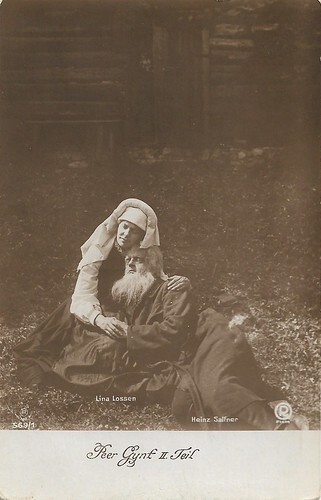
German postcard in the Film Sterne series by Rotophot, no. 569/1. Photo: Richard Oswald-Film. Heinz Salfner as Peer Gynt and Lina Lossen as Solveig in Peer Gynt (Victor Barnowsky, 1919).
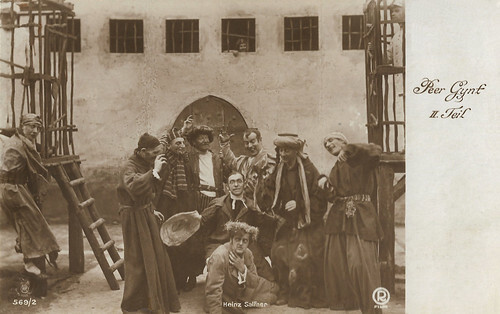
German postcard in the Film Sterne series by Rotophot, no. 569/2. Photo: Richard Oswald-Film. Heinz Salfner as Peer Gynt in Peer Gynt 2. Teil (Victor Barnowsky, 1919).
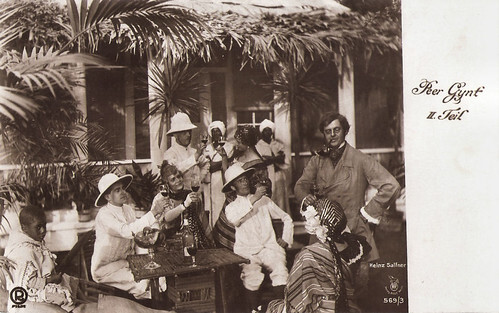
German postcard in the Film Sterne series by Rotophot, no. 569/3. Photo: Richard Oswald-Film. Heinz Salfner as Peer Gynt in Peer Gynt 2. Teil (Victor Barnowsky, 1919).
Part II: Peer's Wanderings and Death
Peer believes that he must now set out into the 'wide world' in search of adventure and prosperity. And so he leaves, leaving behind the kind-hearted Solveig. Gynt subsequently experiences the longed-for adventures.
Three decades later, Peer Gynt has become rich in Africa, among other things through slave trading, and has finally settled in Morocco. There, however, his business partners steal his ship and all his valuable possessions. His ship sinks and Peer seems to have come to terms with his renewed poverty.
In these moments, he finds God and begins to understand what the true values of life are. One day, he is driven by certain circumstances to the Sahara Desert, where he finds salvation in an oasis. Here he meets Anitra ( Anita Berber or Hanna Lierke), as mysterious as she is soulless, who first steals his heart and eventually his remaining possessions.
But he has still not reached the lowest point of his life: in Cairo, Peer Gynt ends up in an insane asylum run by the German doctor Dr. Begriffenfeldt ( Georg John ). But finally, for once, he is lucky. Here he meets compatriots, sailors who have gone ashore locally, who are willing to take the now purified Peer Gynt back to his old home.
Old and impoverished, Peer Gynt returns home, where Solveig has been waiting for him as promised. And the faithful soul has not remained idle all these years: she has managed the dilapidated farm and brought it back to shape. She not only makes sure that Gynt finds a home, but also his salvation with her. Now he can die at peace with himself and his life.
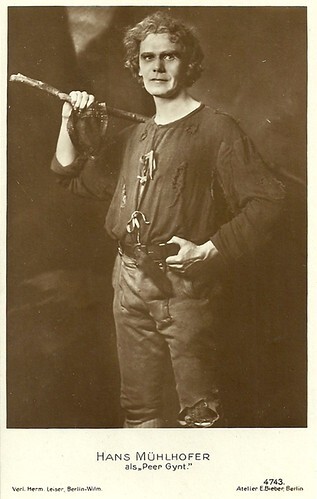
German postcard by Verlag Hermann Leiser, no. 4743. Photo: Atelier Bieber, Berlin. Hans Mühlhofer in one of the many German stage versions of Peer Gynt.
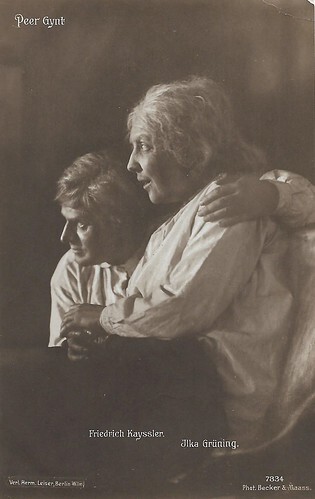
German postcard by Verlag Hermann Leiser, Berlin, no. 7834. Photo: Becker & Maass. Friedrich Kayssler as Peer Gynt and Ilka Grüning as his mother Aase in Ibsen's play 'Peer Gynt'. Kayssler debuted as Peer Gynt in the eponymous play by Ibsen at the Lessingtheater in Berlin, on 15 September 1913. Ilka Grüning already then played his mother Aase. With the Lessing Theater company, Kayssler and Grüning would perform the play in Spring 1914 at the Neues Deutsches Theater in Prague, the Theater an der Wien in Vienna, and the Lobe-Theater at Breslau/Wroclaw.
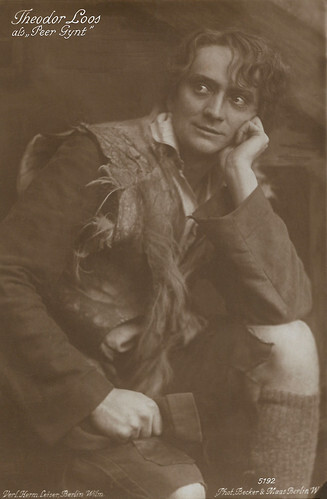
German postcard by Verlag Herm. Leiser, Berlin Wilm., no. 5192. Photo: Becker & Maass, Berlin. Theodor Loos in the play 'Peer Gynt' by Henrik Ibsen.
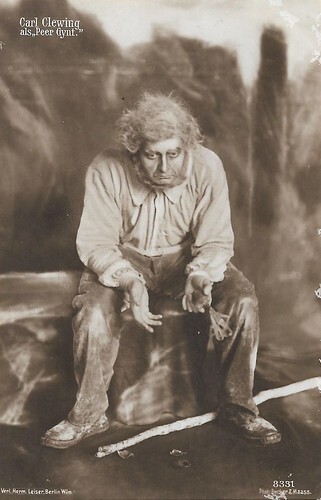
German postcard by Verlag Hermann Leiser, Berlin, no. 8331. Photo: Becker & Maass. Carl Clewing in 'Peer Gynt'. On stage, Clewing was popular in his performance of Ibsen's Peer Gynt, which he staged in 1914, 1915, 1916 and 1919, all at the Königliches Schauspielhaus in Berlin (from 1919: Staatstheater).
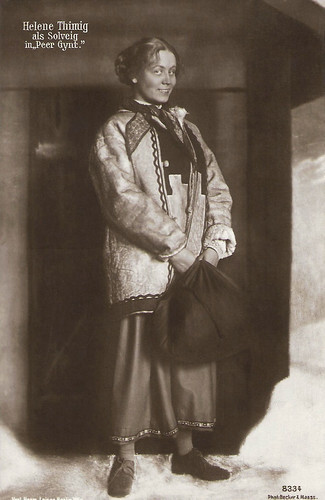
German postcard by Verlag Herm. Leiser, Berlin-Wilm., no. 8334. Photo: Becker & Maass. Caption: Helene Thimig as Solveig in 'Peer Gynt'. Thimig appeared in the play by Henrik Ibsen in 1914-1915.
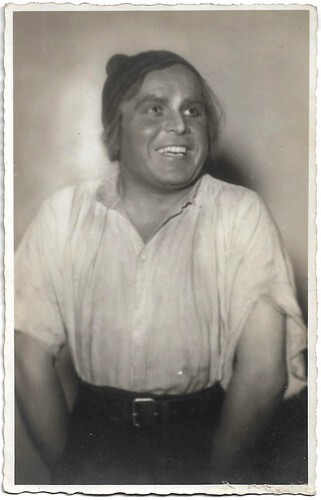
German postcard, 1931-1932. Photo: Arnecke, Cologne. Rudolf Wittgen in 'Peer Gynt' (1931-1932). Wittgen debuted in 'Peer Gynt' in Cologne at the Schauspielhaus on 21 November 1931. The photo on this card must have been made then. Three years before (1928) Wittgen had already played Peer Gynt in Stuttgart at the Württembergisches Landestheater. As far as known, Witten didn't act in cinema.

German collectors card in the series 'Vom Werden deutscher Filmkunst - Der Tonfilm', album no. 11, picture no. 175. Photo: Bavaria-Tofa / Ross Verlag. Marieluise Claudius and Hans Albers in Peer Gynt (Fritz Wendhausen, 1934).
Source: Wikipedia (German and English) and IMDb.

German postcard in the Film-Sterne series by Rotophot, no. 568/2. Photo: Richard Oswald-Film. Ilka Grüning as Aase in Peer Gynt (Victor Barnowsky, 1919).

German postcard in the Film Sterne series by Rotophot, no. 568/3. Photo: Richard Oswald-Film. Heinz Salfner as Peer Gynt and Ilka Grüning as his mother Aase in Peer Gynt (Victor Barnowsky, 1919).
Part I: Peer's Youth
Norway in the 19th century: Peer Gynt (Heinz Salfner) is a powerful peasant boy who tries to steal himself out of his miserable reality with made-up stories. He suppresses the fact that his father Jon Gynt (Hans Sternberg), once a respected man in the village and the surrounding area, is in danger of losing his farm and possessions through mismanagement and alcoholic excesses.
In Peer's imagination, the run-down house is still a magnificent palace. Peer also manages to suppress the fact that he himself is a good-for-nothing. He sees himself as a hero and knows how to make his mother Aase (Ilka Grüning) believe what a 'hotshot' he is.
Aase, for whom the day thief and dreamer Peer means everything to her, transfigures the young man in her imagination, who not only lets the farm degenerate more and more and imagines himself in a world of trolls and demons, but also walks with much enthusiasm but ultimately only little success on suitor's feet.
The button caster ( Conrad Veidt ), a figure from the dreams of his childhood, seduces Gynt into a series of foolish deeds. One day Peer kidnaps Ingrid (Irmgard von Hansen), someone else's bride, while at the same time he meets the decent and demure Solveig (Lina Lossen). Solveig is the exact opposite of Gynt: down-to-earth and faithful. She would be the one to finally set him on the path of virtue. But the restless spirit Peer is drawn to faraway places.

German postcard in the Film Sterne series by Rotophot, no. 569/1. Photo: Richard Oswald-Film. Heinz Salfner as Peer Gynt and Lina Lossen as Solveig in Peer Gynt (Victor Barnowsky, 1919).

German postcard in the Film Sterne series by Rotophot, no. 569/2. Photo: Richard Oswald-Film. Heinz Salfner as Peer Gynt in Peer Gynt 2. Teil (Victor Barnowsky, 1919).

German postcard in the Film Sterne series by Rotophot, no. 569/3. Photo: Richard Oswald-Film. Heinz Salfner as Peer Gynt in Peer Gynt 2. Teil (Victor Barnowsky, 1919).
Part II: Peer's Wanderings and Death
Peer believes that he must now set out into the 'wide world' in search of adventure and prosperity. And so he leaves, leaving behind the kind-hearted Solveig. Gynt subsequently experiences the longed-for adventures.
Three decades later, Peer Gynt has become rich in Africa, among other things through slave trading, and has finally settled in Morocco. There, however, his business partners steal his ship and all his valuable possessions. His ship sinks and Peer seems to have come to terms with his renewed poverty.
In these moments, he finds God and begins to understand what the true values of life are. One day, he is driven by certain circumstances to the Sahara Desert, where he finds salvation in an oasis. Here he meets Anitra ( Anita Berber or Hanna Lierke), as mysterious as she is soulless, who first steals his heart and eventually his remaining possessions.
But he has still not reached the lowest point of his life: in Cairo, Peer Gynt ends up in an insane asylum run by the German doctor Dr. Begriffenfeldt ( Georg John ). But finally, for once, he is lucky. Here he meets compatriots, sailors who have gone ashore locally, who are willing to take the now purified Peer Gynt back to his old home.
Old and impoverished, Peer Gynt returns home, where Solveig has been waiting for him as promised. And the faithful soul has not remained idle all these years: she has managed the dilapidated farm and brought it back to shape. She not only makes sure that Gynt finds a home, but also his salvation with her. Now he can die at peace with himself and his life.

German postcard by Verlag Hermann Leiser, no. 4743. Photo: Atelier Bieber, Berlin. Hans Mühlhofer in one of the many German stage versions of Peer Gynt.

German postcard by Verlag Hermann Leiser, Berlin, no. 7834. Photo: Becker & Maass. Friedrich Kayssler as Peer Gynt and Ilka Grüning as his mother Aase in Ibsen's play 'Peer Gynt'. Kayssler debuted as Peer Gynt in the eponymous play by Ibsen at the Lessingtheater in Berlin, on 15 September 1913. Ilka Grüning already then played his mother Aase. With the Lessing Theater company, Kayssler and Grüning would perform the play in Spring 1914 at the Neues Deutsches Theater in Prague, the Theater an der Wien in Vienna, and the Lobe-Theater at Breslau/Wroclaw.

German postcard by Verlag Herm. Leiser, Berlin Wilm., no. 5192. Photo: Becker & Maass, Berlin. Theodor Loos in the play 'Peer Gynt' by Henrik Ibsen.

German postcard by Verlag Hermann Leiser, Berlin, no. 8331. Photo: Becker & Maass. Carl Clewing in 'Peer Gynt'. On stage, Clewing was popular in his performance of Ibsen's Peer Gynt, which he staged in 1914, 1915, 1916 and 1919, all at the Königliches Schauspielhaus in Berlin (from 1919: Staatstheater).

German postcard by Verlag Herm. Leiser, Berlin-Wilm., no. 8334. Photo: Becker & Maass. Caption: Helene Thimig as Solveig in 'Peer Gynt'. Thimig appeared in the play by Henrik Ibsen in 1914-1915.

German postcard, 1931-1932. Photo: Arnecke, Cologne. Rudolf Wittgen in 'Peer Gynt' (1931-1932). Wittgen debuted in 'Peer Gynt' in Cologne at the Schauspielhaus on 21 November 1931. The photo on this card must have been made then. Three years before (1928) Wittgen had already played Peer Gynt in Stuttgart at the Württembergisches Landestheater. As far as known, Witten didn't act in cinema.

German collectors card in the series 'Vom Werden deutscher Filmkunst - Der Tonfilm', album no. 11, picture no. 175. Photo: Bavaria-Tofa / Ross Verlag. Marieluise Claudius and Hans Albers in Peer Gynt (Fritz Wendhausen, 1934).
Source: Wikipedia (German and English) and IMDb.
Published on October 26, 2021 22:00
October 25, 2021
Baby LeRoy
Baby LeRoy (1932-2001) was Hollywood's most famous toddler. When he was only 16 months old, he became the youngest person ever put under term contract by a major studio. Between 1933 and 1935 he starred in nine films, always as a baby. These included A Bedtime Story (1933) with Maurice Chevalier, Alice in Wonderland (1933), and Torch Singer (1933). He is best known for his appearances in three W.C. Fields films: Tillie and Gus (1933), The Old Fashioned Way (1934) and It's a Gift (1934).
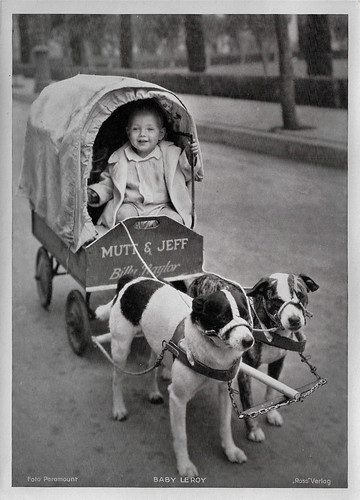
Big German collectors card by Ross Verlag. Photo: Paramount. Baby LeRoy embarks on a tour of the Paramount studios in a cart pulled by two dogs, Mutt and Jeff, Hollywood, circa 1934.
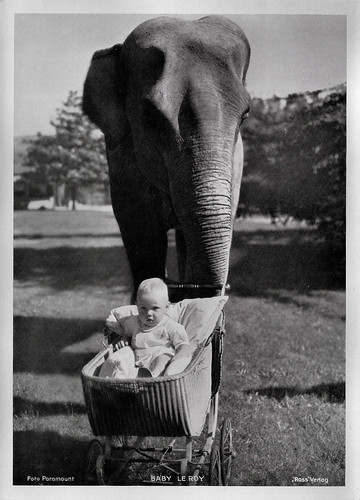
Big German collectors card by Ross Verlag. Photo: Paramount.
The youngest motion picture actor to receive star billing
Baby LeRoy was born in 1932 in Los Angeles, as Ronald Le Roy Overacker.
Aged six months, he made his screen debut in A Bedtime Story (Norman Taurog, 1933). The star of the film was Maurice Chevalier as a Parisian playboy who plays father to an abandoned, troublesome baby who severely diminishes his lovemaking activities.
LeRoy's contract with Paramount had to be signed by his grandfather, as not only was Baby LeRoy underage but so was his 16-year-old mother. He was the youngest motion picture actor to receive star billing in such films as Alice in Wonderland (Norman Z. McLeod, 1933), a star-laden version of Lewis Carroll's novel, and the musical drama Torch Singer (Alexander Hall, George Somnes, 1933), starring Claudette Colbert .
He co-starred with W.C. Fields in the comedies Tillie and Gus (Francis Martin, 1933), The Old Fashioned Way (William Beaudine, 1934) and It's a Gift (Norman Z. MacLeod, 1934). Fields recounted a difficult shooting day during Tillie and Gus where a short scene was repeatedly ruined by Baby LeRoy's crying until he surreptitiously devised a solution: "I quietly removed the nipple from Baby LeRoy's bottle, dropped in a couple of noggins of gin, and returned it to Baby LeRoy. After sucking on the pacifier for a few minutes, he staggered through the scene like a Barrymore."
LeRoy is perhaps best remembered for a dinner table sequence in The Old Fashioned Way (1934) in which he throws a handful of custard into W.C. Fields's face, yanks on his nose, and destroys his pocket watch by tossing it into a bowl of molasses. Fields initially endures each of these indignities, but the scene ends with Fields spotting Baby LeRoy standing in a doorway and giving the toddler a kick to the rear end.
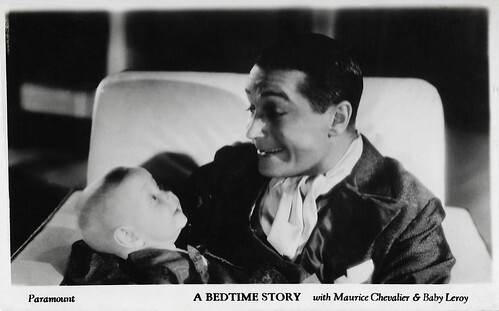
British postcard in the Filmshots series by Film Weekly. Photo: Paramount. Maurice Chevalier and Baby LeRoy in A Bedtime Story (Norman Taurog, 1933). Caption: Real Still from Films.
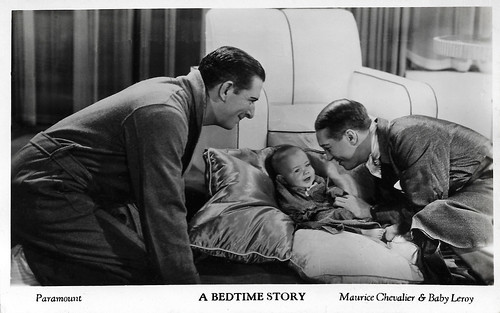
British postcard in the Film Shots series by Film Weekly. Edward Everett Horton, Baby LeRoy and Maurice Chevalier in A Bedtime Story (Norman Taurog, 1933). Photo: Paramount.
A comeback film at age 8
Baby Leroy is said to have retired from motion pictures at age 4, but four years later there was a final chapter of his film career. At age 8, LeRoy landed the lead role in Paramount's The Biscuit Eater (Stuart Heisler, 1940).
This was to be his comeback film, after a two-year absence from the big screen. At age 6, he had appeared in a bit part as himself in the comedy short, Cinema Circus (Roy Rowland, 1937).
He began filming the opening scene of The Biscuit Eater (1940) in October 1939. The scene called for Baby LeRoy to swing across a lake holding a rope, but he lost his grip and fell into the lake as the cameras rolled. This happened both times that the scene was attempted.
As a result, Baby LeRoy became ill with a very bad cold. By the next day, he had lost his voice. As filming was on location in Albany, Georgia, and the crew and the rest of the cast could not wait the two weeks for the young actor to recover, as the doctor who examined LeRoy had determined, the film's director, Stuart Heisler, instead placed an emergency call to Paramount in Hollywood.
Paramount wasted no time replacing Baby Leroy with another Paramount child actor, Billy Lee, who soon arrived with his father who was managing his career, while Baby LeRoy was sent back to Hollywood to recover from his illness, with a promise from Paramount that he would be given another lead role for another chance at a comeback.
Unfortunately, that never materialised. Overacker became a merchant seaman and in 1957, as an adult, appeared as a guest challenger on the TV panel show To Tell the Truth. Ronald Le Roy Overacker died in 2001 in Van Nuys, California. He was 69.
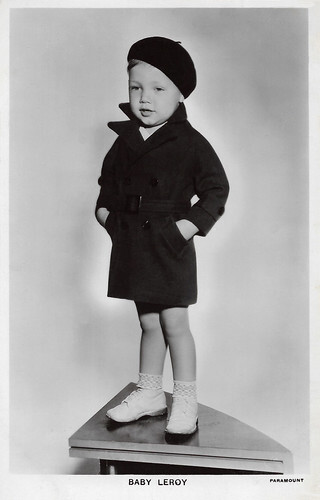
British postcard in the Picturegoer Series, London, no. 935. Photo: Paramount.
Sources: AllMovie, Wikipedia, and .

Big German collectors card by Ross Verlag. Photo: Paramount. Baby LeRoy embarks on a tour of the Paramount studios in a cart pulled by two dogs, Mutt and Jeff, Hollywood, circa 1934.

Big German collectors card by Ross Verlag. Photo: Paramount.
The youngest motion picture actor to receive star billing
Baby LeRoy was born in 1932 in Los Angeles, as Ronald Le Roy Overacker.
Aged six months, he made his screen debut in A Bedtime Story (Norman Taurog, 1933). The star of the film was Maurice Chevalier as a Parisian playboy who plays father to an abandoned, troublesome baby who severely diminishes his lovemaking activities.
LeRoy's contract with Paramount had to be signed by his grandfather, as not only was Baby LeRoy underage but so was his 16-year-old mother. He was the youngest motion picture actor to receive star billing in such films as Alice in Wonderland (Norman Z. McLeod, 1933), a star-laden version of Lewis Carroll's novel, and the musical drama Torch Singer (Alexander Hall, George Somnes, 1933), starring Claudette Colbert .
He co-starred with W.C. Fields in the comedies Tillie and Gus (Francis Martin, 1933), The Old Fashioned Way (William Beaudine, 1934) and It's a Gift (Norman Z. MacLeod, 1934). Fields recounted a difficult shooting day during Tillie and Gus where a short scene was repeatedly ruined by Baby LeRoy's crying until he surreptitiously devised a solution: "I quietly removed the nipple from Baby LeRoy's bottle, dropped in a couple of noggins of gin, and returned it to Baby LeRoy. After sucking on the pacifier for a few minutes, he staggered through the scene like a Barrymore."
LeRoy is perhaps best remembered for a dinner table sequence in The Old Fashioned Way (1934) in which he throws a handful of custard into W.C. Fields's face, yanks on his nose, and destroys his pocket watch by tossing it into a bowl of molasses. Fields initially endures each of these indignities, but the scene ends with Fields spotting Baby LeRoy standing in a doorway and giving the toddler a kick to the rear end.

British postcard in the Filmshots series by Film Weekly. Photo: Paramount. Maurice Chevalier and Baby LeRoy in A Bedtime Story (Norman Taurog, 1933). Caption: Real Still from Films.

British postcard in the Film Shots series by Film Weekly. Edward Everett Horton, Baby LeRoy and Maurice Chevalier in A Bedtime Story (Norman Taurog, 1933). Photo: Paramount.
A comeback film at age 8
Baby Leroy is said to have retired from motion pictures at age 4, but four years later there was a final chapter of his film career. At age 8, LeRoy landed the lead role in Paramount's The Biscuit Eater (Stuart Heisler, 1940).
This was to be his comeback film, after a two-year absence from the big screen. At age 6, he had appeared in a bit part as himself in the comedy short, Cinema Circus (Roy Rowland, 1937).
He began filming the opening scene of The Biscuit Eater (1940) in October 1939. The scene called for Baby LeRoy to swing across a lake holding a rope, but he lost his grip and fell into the lake as the cameras rolled. This happened both times that the scene was attempted.
As a result, Baby LeRoy became ill with a very bad cold. By the next day, he had lost his voice. As filming was on location in Albany, Georgia, and the crew and the rest of the cast could not wait the two weeks for the young actor to recover, as the doctor who examined LeRoy had determined, the film's director, Stuart Heisler, instead placed an emergency call to Paramount in Hollywood.
Paramount wasted no time replacing Baby Leroy with another Paramount child actor, Billy Lee, who soon arrived with his father who was managing his career, while Baby LeRoy was sent back to Hollywood to recover from his illness, with a promise from Paramount that he would be given another lead role for another chance at a comeback.
Unfortunately, that never materialised. Overacker became a merchant seaman and in 1957, as an adult, appeared as a guest challenger on the TV panel show To Tell the Truth. Ronald Le Roy Overacker died in 2001 in Van Nuys, California. He was 69.

British postcard in the Picturegoer Series, London, no. 935. Photo: Paramount.
Sources: AllMovie, Wikipedia, and .
Published on October 25, 2021 22:00
October 24, 2021
Fritz Delius
Fritz Delius (1890-1966) was a German stage actor who played many leading roles in productions by Max Reinhardt. He was also one of the pioneers of German silent cinema. Delius acted with such stars as Henny Porten, Fern Andra, and Hedda Vernon, and also wrote film scripts. After the advent of sound film, he shifted his focus to theater. As a Jew, he had to leave Germany when the Nazis rose to power and in 1938 he emigrated to Switzerland where he was able to continue his theatre and film career.
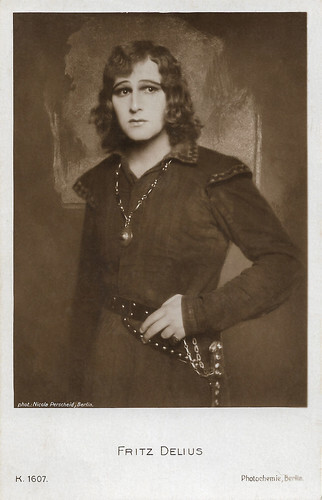
German postcard by Photochemie, Berlin, no, K. 1607. Photo: Nicola Perscheid. Fritz Delius, possibly as the title character in Shakespeare's 'Hamlet'.
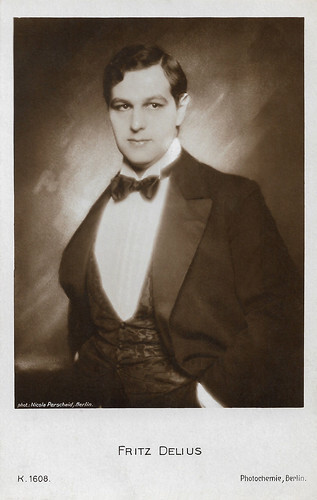
German postcard by Photochemie, Berlin, no. K. 1608. Photo: Nicola Perscheid.
A youthful hero and character actor with Max Reinhardt
Fritz Delius was born Friedrich Wilhelm Diamant in 1890 in Berlin, Germany. Delius debuted as a stage actor in 1909 at the Hoftheater (Meiningen Court Theatre) in Meiningen, then had engagements at the Goethe Festival in Düsseldorf and, among others, at the Meinhard-Bernauer-Bühnen in Berlin.
From 1913, he was a youthful hero and character actor with Max Reinhardt at the Deutsches Theater at the Kammerspiele and at the Volksbühne Berlin. His roles included Ferdinand in Friedrich Schiller's 'Kabale und Liebe' and Mortimer in 'Maria Stuart', Alwa Schön in Frank Wedekind's 'Erdgeist' and 'Pandora's Box', and Lysander/Demetrius in William Shakespeare's 'A Midsummer Night's Dream'.
Delius also played the title roles in 'Hamlet' and 'Romeo and Juliet' and in Heinrich von Kleist's 'Prince Frederick of Homburg', and Riccaut in Friedrich Lessing's 'Minna von Barnhelm'. From 1926 till 1938 he acted at the Theater in der Josefstadt, Vienna, as a guest at the Salzburg Festival, and in 1926/1927 and 1928/1929 at the Schauspielhaus Zürich.
In 1938 Delius emigrated to Switzerland via Budapest and Italy. In the years 1938-1950 he played there under the direction of Oskar Wälterlin at the Schauspielhaus Zurich where he did some 150 roles, including Attinghausen in Friedrich Schiller's 'Wilhelm Tell', Philemon in Goethe's 'Faust II', and Zeno in Friedrich Dürrenmatt's 'Romulus der Grosse'.
He played Werber in the world premiere of Bertolt Brecht's 'Mother Courage and Her Children', Doctor in the world premiere of Max Frisch's 'Santa Cruz', and Landgrave of Hesse in the world premiere of Friedrich Dürrenmatt's 'Es steht geschrieben'. He also did several guest appearances from 1941 onward at the Sommertheater Winterthur, including the title role in Lessing's 'Nathan der Weise' and Mephisto in Goethe's 'Faust'.
In the years 1950-1966, Fritz Delius acted under the direction of Egon Karter at the newly founded Komödie Basel. He appeared as Jasmin Boisette in Verneuil's 'Es bleibt in der Familie', Sultan Saladin in Lessing's 'Nathan der Weise', and as Pastor Manders in Henrik Ibsen's 'Ghosts' with Johanna Terwin-Moissi as Frau Alving. For his stage work, he won several awards such as the Grosses goldenes Ehrenzeichen der Genossenschaft Deutscher Bühnen-Angehöriger in 1965.
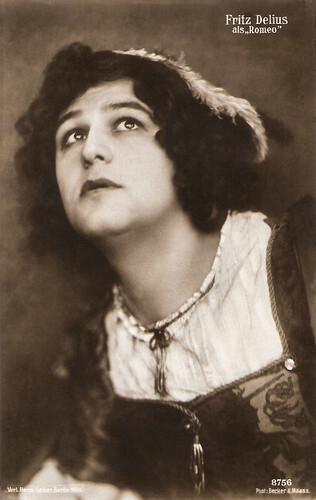
German postcard by Herm. Leiser, Berlin-Wilm., no. 8756. Photo: Becker & Maass. Fritz Delius as Romeo in 'Romeo and Juliet' by William Shakespeare, probably under the direction of Max Reinhardt, ca. 1913.
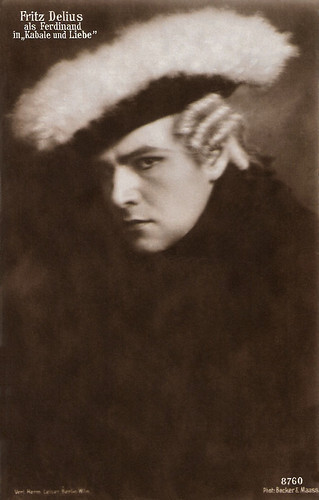
German postcard by Herm. Leiser, Berlin-Wilm., no. 8760. Photo: Becker & Maass. Fritz Delius as Ferdinand in a 1917 stage production of Friedrich Schiller's 'Kabale und Liebe' (Intrigue and Love), under the direction of Max Reinhardt.
Writing for Henny Porten
When the production of silent films seriously started during the First World War, Fritz Delius made his screen debut with a rather small part alongside Henny Porten in Rudolf Biebrach's drama Die Wellen schweigen/The Waves Are Silent (1915). In his second film, also directed by Biebrach, he was already entrusted with a leading role and played the doctor Professor Volkmann, who sacrifices his own blood to save the young Margarete Lasson ( Henny Porten ) in the marriage tragedy Das große Schweigen/The Great Silence (1916). When Margarete falls in love with Volkmann's colleague Dr. Falk (Fritz Weidemann) after marrying him, disaster strikes ...
Fritz Delius also wrote the screenplay for two films with Porten, Der Ruf der Liebe (1916) and Abseits vom Glück (1916), in which he also was her co-star. Further silent melodramas and adventures followed, in which Fritz Delius played incisive roles alongside silent film stars such as Fern Andra in Ernst ist das Leben/Life is Serious (Fern Andra, 1916), or Hedda Vernon in Die Erbin (1919), Der Peitschenhieb (1919), and Das Frauenhaus von Brescia/The Women House of Brescia (Hubert Moest, 1920).
Reinhold Schünzel cast Fritz Delius in Katharina die Große/Catherine the Great (1920), his opulent monumental portrait of the famous Russian empress Catherine II, embodied by Lucie Höflich, which was shot with around 4,000 actors and extras. Fritz Delius, as Gregor Count Orlov, played one of Catherine's lovers. After Léo Lasko's two-part Auri sacra fames/Der verfluchte Hunger nach Gold (1920), with Rosa Porten and Werner Funck, Delius embodied Louis XIV in Louise de Lavallière - Am Liebeshof des Sonnenkönigs/Louise de Lavallière (Georg Burghardt, 1922) alongside Emmy Schaeff as his mistress, the French courtesan Louise de La Vallière.
In the fourth part of Arzén von Cserépy's monumental Fridericus Rex series entitled Schicksalswende (1923), with Otto Gebühr as Prussian King Frederick II, Delius portrayed the Austrian army commander Prince Karl Alexander von Lothringen. With Johannes Guter's Der Turm des Schweigens (1925), based on Shakespeare's play 'The Tempest', Fritz Delius ended his rather short but nevertheless intensive film career for the time being.
He played the aviator or celebrated scientist Wilfred Durian, who once crashed together with Arved Holl (Nigel Barrie) during an exploratory flight over the Australian Victoria Desert and then abandoned his friend. When Holl, thought lost, reappears, Durian is confronted with his guilt, family secrets come to light, and young Eva ( Xenia Desni ) learns who she really is from her supposed father, tower keeper Eldor Vartalun (Avrom Morewski).
After that, Fritz Delius only appeared on screen once more in Felix Basch's Seine Freundin Annette (1931) and in smaller roles in the Swiss productions Landammann Stauffacher (1941) and Matto regiert/Madness Rules (1947), directed by Leopold Lindtberg and starring Heinrich Gretler. Fritz Delius passed away in 1966 in Basel, Switzerland, a few days before his 76th birthday.
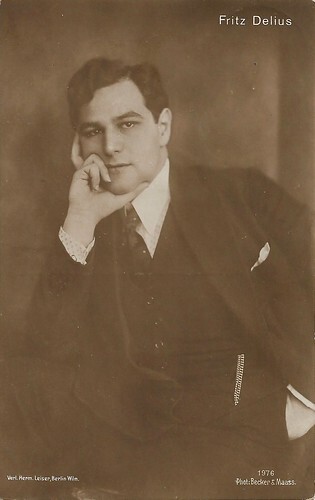
German postcard by Verlag Hermann Leiser, Berlin, no. 1976. Photo: Becker & Maass.
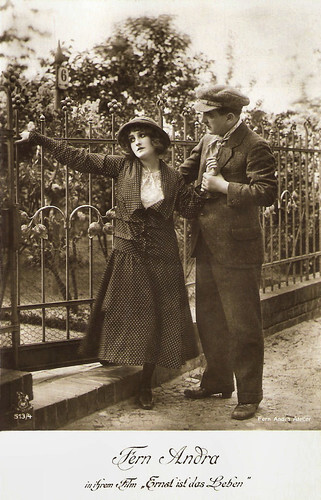
German postcard by Rotophot in the Film Sterne series, no. 513/4. Photo: Fern Andra Atelier. Fern Andra in Ernst ist das Leben/Life is Serious (Fern Andra, 1916). The actor is probably Fritz Delius. This card was sent to us by Gill4kleuren (Many thanks, Gill!).
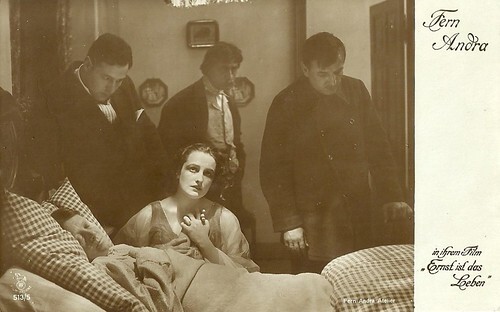
German postcard by Rotophot in the Film Sterne series, no. 513/5. Photo: Fern Andra Atelier. Fern Andra in Ernst ist das Leben/Life is Serious (Fern Andra, 1916). The man on the left of Fern Andra could be Fritz Delius. The dying woman in the bed could be Frida Richard, who plays Andra's mother in the film.
Sources: Stephanie d'Heil (Steffi-line.de - German), Thomas Blubacher (Theaterlexikon der Schweiz - German), Thomas Staedeli (Cyranos), Wikipedia and .

German postcard by Photochemie, Berlin, no, K. 1607. Photo: Nicola Perscheid. Fritz Delius, possibly as the title character in Shakespeare's 'Hamlet'.

German postcard by Photochemie, Berlin, no. K. 1608. Photo: Nicola Perscheid.
A youthful hero and character actor with Max Reinhardt
Fritz Delius was born Friedrich Wilhelm Diamant in 1890 in Berlin, Germany. Delius debuted as a stage actor in 1909 at the Hoftheater (Meiningen Court Theatre) in Meiningen, then had engagements at the Goethe Festival in Düsseldorf and, among others, at the Meinhard-Bernauer-Bühnen in Berlin.
From 1913, he was a youthful hero and character actor with Max Reinhardt at the Deutsches Theater at the Kammerspiele and at the Volksbühne Berlin. His roles included Ferdinand in Friedrich Schiller's 'Kabale und Liebe' and Mortimer in 'Maria Stuart', Alwa Schön in Frank Wedekind's 'Erdgeist' and 'Pandora's Box', and Lysander/Demetrius in William Shakespeare's 'A Midsummer Night's Dream'.
Delius also played the title roles in 'Hamlet' and 'Romeo and Juliet' and in Heinrich von Kleist's 'Prince Frederick of Homburg', and Riccaut in Friedrich Lessing's 'Minna von Barnhelm'. From 1926 till 1938 he acted at the Theater in der Josefstadt, Vienna, as a guest at the Salzburg Festival, and in 1926/1927 and 1928/1929 at the Schauspielhaus Zürich.
In 1938 Delius emigrated to Switzerland via Budapest and Italy. In the years 1938-1950 he played there under the direction of Oskar Wälterlin at the Schauspielhaus Zurich where he did some 150 roles, including Attinghausen in Friedrich Schiller's 'Wilhelm Tell', Philemon in Goethe's 'Faust II', and Zeno in Friedrich Dürrenmatt's 'Romulus der Grosse'.
He played Werber in the world premiere of Bertolt Brecht's 'Mother Courage and Her Children', Doctor in the world premiere of Max Frisch's 'Santa Cruz', and Landgrave of Hesse in the world premiere of Friedrich Dürrenmatt's 'Es steht geschrieben'. He also did several guest appearances from 1941 onward at the Sommertheater Winterthur, including the title role in Lessing's 'Nathan der Weise' and Mephisto in Goethe's 'Faust'.
In the years 1950-1966, Fritz Delius acted under the direction of Egon Karter at the newly founded Komödie Basel. He appeared as Jasmin Boisette in Verneuil's 'Es bleibt in der Familie', Sultan Saladin in Lessing's 'Nathan der Weise', and as Pastor Manders in Henrik Ibsen's 'Ghosts' with Johanna Terwin-Moissi as Frau Alving. For his stage work, he won several awards such as the Grosses goldenes Ehrenzeichen der Genossenschaft Deutscher Bühnen-Angehöriger in 1965.

German postcard by Herm. Leiser, Berlin-Wilm., no. 8756. Photo: Becker & Maass. Fritz Delius as Romeo in 'Romeo and Juliet' by William Shakespeare, probably under the direction of Max Reinhardt, ca. 1913.

German postcard by Herm. Leiser, Berlin-Wilm., no. 8760. Photo: Becker & Maass. Fritz Delius as Ferdinand in a 1917 stage production of Friedrich Schiller's 'Kabale und Liebe' (Intrigue and Love), under the direction of Max Reinhardt.
Writing for Henny Porten
When the production of silent films seriously started during the First World War, Fritz Delius made his screen debut with a rather small part alongside Henny Porten in Rudolf Biebrach's drama Die Wellen schweigen/The Waves Are Silent (1915). In his second film, also directed by Biebrach, he was already entrusted with a leading role and played the doctor Professor Volkmann, who sacrifices his own blood to save the young Margarete Lasson ( Henny Porten ) in the marriage tragedy Das große Schweigen/The Great Silence (1916). When Margarete falls in love with Volkmann's colleague Dr. Falk (Fritz Weidemann) after marrying him, disaster strikes ...
Fritz Delius also wrote the screenplay for two films with Porten, Der Ruf der Liebe (1916) and Abseits vom Glück (1916), in which he also was her co-star. Further silent melodramas and adventures followed, in which Fritz Delius played incisive roles alongside silent film stars such as Fern Andra in Ernst ist das Leben/Life is Serious (Fern Andra, 1916), or Hedda Vernon in Die Erbin (1919), Der Peitschenhieb (1919), and Das Frauenhaus von Brescia/The Women House of Brescia (Hubert Moest, 1920).
Reinhold Schünzel cast Fritz Delius in Katharina die Große/Catherine the Great (1920), his opulent monumental portrait of the famous Russian empress Catherine II, embodied by Lucie Höflich, which was shot with around 4,000 actors and extras. Fritz Delius, as Gregor Count Orlov, played one of Catherine's lovers. After Léo Lasko's two-part Auri sacra fames/Der verfluchte Hunger nach Gold (1920), with Rosa Porten and Werner Funck, Delius embodied Louis XIV in Louise de Lavallière - Am Liebeshof des Sonnenkönigs/Louise de Lavallière (Georg Burghardt, 1922) alongside Emmy Schaeff as his mistress, the French courtesan Louise de La Vallière.
In the fourth part of Arzén von Cserépy's monumental Fridericus Rex series entitled Schicksalswende (1923), with Otto Gebühr as Prussian King Frederick II, Delius portrayed the Austrian army commander Prince Karl Alexander von Lothringen. With Johannes Guter's Der Turm des Schweigens (1925), based on Shakespeare's play 'The Tempest', Fritz Delius ended his rather short but nevertheless intensive film career for the time being.
He played the aviator or celebrated scientist Wilfred Durian, who once crashed together with Arved Holl (Nigel Barrie) during an exploratory flight over the Australian Victoria Desert and then abandoned his friend. When Holl, thought lost, reappears, Durian is confronted with his guilt, family secrets come to light, and young Eva ( Xenia Desni ) learns who she really is from her supposed father, tower keeper Eldor Vartalun (Avrom Morewski).
After that, Fritz Delius only appeared on screen once more in Felix Basch's Seine Freundin Annette (1931) and in smaller roles in the Swiss productions Landammann Stauffacher (1941) and Matto regiert/Madness Rules (1947), directed by Leopold Lindtberg and starring Heinrich Gretler. Fritz Delius passed away in 1966 in Basel, Switzerland, a few days before his 76th birthday.

German postcard by Verlag Hermann Leiser, Berlin, no. 1976. Photo: Becker & Maass.

German postcard by Rotophot in the Film Sterne series, no. 513/4. Photo: Fern Andra Atelier. Fern Andra in Ernst ist das Leben/Life is Serious (Fern Andra, 1916). The actor is probably Fritz Delius. This card was sent to us by Gill4kleuren (Many thanks, Gill!).

German postcard by Rotophot in the Film Sterne series, no. 513/5. Photo: Fern Andra Atelier. Fern Andra in Ernst ist das Leben/Life is Serious (Fern Andra, 1916). The man on the left of Fern Andra could be Fritz Delius. The dying woman in the bed could be Frida Richard, who plays Andra's mother in the film.
Sources: Stephanie d'Heil (Steffi-line.de - German), Thomas Blubacher (Theaterlexikon der Schweiz - German), Thomas Staedeli (Cyranos), Wikipedia and .
Published on October 24, 2021 22:00
October 23, 2021
Tommy Lee Jones
American actor Tommy Lee Jones (1946), known for his deadpan delivery, played hard-edged but sarcastic law enforcement and military officers in such blockbusters as the thriller The Fugitive (1993) opposite Harrison Ford and the Men in Black series with Will Smith. He received four Oscar nominations, for JFK (1991), The Fugitive (1993), In the Valley of Elah (2007), and Lincoln (2012), and won the award for The Fugitive. Other acclaimed films in which he appeared include Coal Miner's Daughter (1980), and No Country for Old Men (2007).
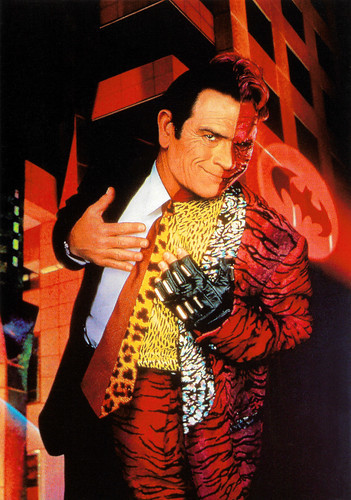
American postcard by Slow Dazzle Worldwide, no. 19 in a series of 16, no. 1621. Photo: DC Comics, 1995. Tommy Lee Jones as Harvey Two-Face in Batman Forever (Joel Schumacher, 1995). Caption: Half man, half madman, he's the ultimate dual personality. Two-Face is the former Gotham City district attorney Harvey Dent, who mistakenly blames Batman for an accident that left one side of his face grotesquely deformed. And now he's out to get Batman!
A strong, explosive, thoughtful actor who could handle supporting and leading roles
Tommy Lee Jones was born in 1946 in San Saba, Texas. He was the son of Lucille Marie (Scott), a police officer and beauty shop owner, and Clyde C. Jones, who worked on oil fields. Tommy himself worked in underwater construction and on an oil rig.
He attended St. Mark's School of Texas, a prestigious prep school for boys in Dallas, on a scholarship. On another scholarship, he attended Harvard University, where he roomed with future U.S. Vice President Al Gore. Though several of his less-knowledgeable fans have tended to dismiss Jones as a roughhewn redneck, the actor was equally at home on the polo fields (he's a champion player) as the oil fields. He received a B.A. in English literature and graduated cum laude from Harvard in 1969.
Following college, he moved to New York and began his stage career on Broadway in 'A Patriot for Me' with Maximilian Schell , which closed after 49 performances. In 1970, he appeared in his first film, Love Story (Arthur Hiller, 1970), listed way, way down the cast list as one of Ryan O'Neal's fraternity buddies. Interestingly enough, while Jones was at Harvard, he and roommate Gore provided the models for author Erich Segal while he was writing the character of Oliver, the book's (and film's) protagonist.
While living in New York, he continued to appear in various plays, both on- and off-Broadway: 'Fortune and Men's Eyes' (1969), Abe Burrows' 'Four on a Garden' (1971), 'Blue Boys' (1972), and 'Ulysses in Nighttown (1974). Between 1971 and 1975 he portrayed Dr. Mark Toland on the ABC soap opera, One Life to Live. Jones got his first film lead in the obscure Canadian film Eliza's Horoscope (Gordon Sheppard, 1975).
With his first wife, Kate Lardner, granddaughter of short-story writer/columnist Ring Lardner, and her two children from a previous marriage, he moved to Los Angeles. Jones gained national attention in 1977 when he was cast in the title role in the TV miniseries The Amazing Howard Hughes (William A. Graham, 1977). His resemblance to the American aviation pioneer and filmmaker - both vocally and visually - was positively uncanny.
In the cinema, he played an escaped convict hunted in the exploitation crime thriller Jackson County Jail (Michael Miller, 1976), a Vietnam veteran in the thriller Rolling Thunder (John Flynn, 1977), based on a story by Paul Schrader, an automobile mogul in the Harold Robbins drama The Betsy (Daniel Petrie, 1978) with Laurence Olivier , and opposite Faye Dunaway in the thriller Eyes of Laura Mars (Irvin Kershner, 1978), written by John Carpenter.
In 1980, Jones earned his first Golden Globe nomination for his portrayal of country singer Loretta Lynn's husband, Doolittle "Mooney" Lynn, in Coal Miner's Daughter (Michael Apted, 1980), starring Sissy Spacek. While working on the film Back Roads (Martin Ritt, 1981), he met and fell in love with Kimberlea Cloughley, whom he later married.
Jones won further acclaim and an Emmy for his startling performance as murderer Gary Gilmore in The Executioner's Song (Lawrence Schiller, 1982), based on the book by Norman Mailer. Maria Vitale at IMDb : "More roles in television, on stage, and in films garnered him a reputation as a strong, explosive, thoughtful actor who could handle supporting as well as leading roles." Jones spent the rest of the 1980s working in both television and film, doing his most notable work on such TV miniseries as Lonesome Dove (Simon Wincer, 1989), for which he earned another Emmy nomination.
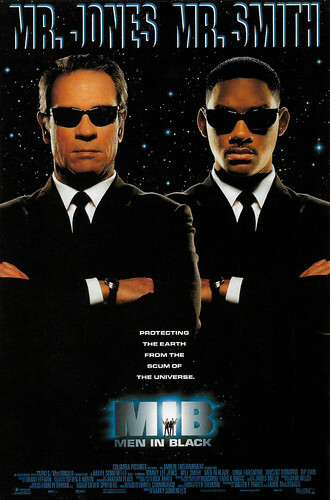
British postcard by Star Images, London, no. M.002. Photo: Columbia Pictures, 1997. Tommy Lee Jones and Will Smith in Men in Black (Barry Sonnenfeld, 1997). Caption: Mr. Jones, Mr. Smith, protecting the earth from the scum of the universe.
A Golden Globe for his driven, starkly funny portrayal of a U.S. Marshal
It was not until the early 1990s that Tommy Lee Jones became a substantial figure in Hollywood, a position catalyzed by a Best Supporting Actor Oscar nomination for his role in Oliver Stone's epic political thriller JFK (1991) which examines the events leading to the assassination of John F. Kennedy in 1963 and the alleged cover-up through the eyes of former New Orleans district attorney Jim Garrison ( Kevin Costner ).
In 1993, Jones won both that award and a Golden Globe for his driven, starkly funny portrayal of U.S. Marshal Sam Gerard in The Fugitive (Andrew Davis, 1993), starring Harrison Ford. His subsequent work during the decade was prolific and enormously varied.
In 1994 alone, he could be seen as an insane prison warden in Natural Born Killers (Oliver Stone, 1994); titular baseball hero Ty Cobb in Cobb (Ron Shelton, 1994); a troubled army captain in Blue Sky (Tony Richardson, 1994); a wily federal attorney in the John Grisham adaptation The Client (Joel Schumacher, 1994); and a psychotic bomber in Blown Away (Stephen Hopkins, 1994) opposite Jeff Bridges.
Jones was also attached to a number of big-budget action films, hamming it up as the crazed Two-Face in Batman Forever (Joel Schumacher, 1995); donning sunglasses and an attitude to play special agent K in Men in Black (Barry Sonnenfeld, 1997); and reprising his Fugitive role for the film's sequel, U.S. Marshals (Stuart Baird, 1998).
The following year, he continued this trend, playing Ashley Judd's parole officer in the psychological thriller Double Jeopardy (Bruce Beresford, 1999). The late 1990s and millennial turnover found Jones' popularity soaring, and the distinguished actor continued to develop a successful comic screen persona in such films as Space Cowboys (Clint Eastwood, 2000) and Men in Black II (Barry Sonnenfeld, 2002), in addition to maintaining his dramatic clout with roles in such thrillers as Rules of Engagement (William Friedkin, 2000) and The Hunted (William Friedkin, 2003).
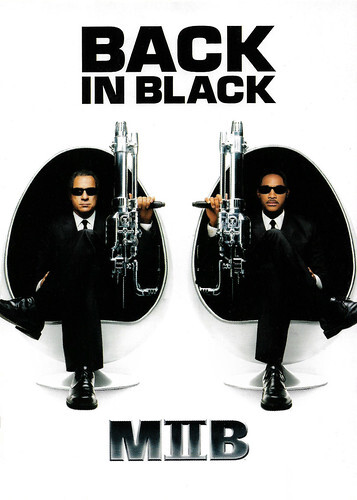
Dutch postcard by Boomerang. Photo: Amblin Entertainment / Columbia Pictures. Tommy Lee Jones and Will Smith in Men in Black II (Barry Sonnenfeld, 2002). Caption: Back in black.
The consummate corporate bad guy played with his trademark grit
2005 brought a comedic turn for Tommy Lee Jones who starred in the madcap comedy Man of the House (Stephen Herek, 2005) as a grizzled police officer who has to protect a house full of cheerleaders who witnessed a murder. Jones also took a stab at directing that year, helming and starring in the Neo-Western The Three Burials of Melquiades Estrada (Tommy Lee Jones, 2005). His performance won him the Best Actor Award at the 2005 Cannes Film Festival.
Jones appeared in the film adaptation of A Prairie Home Companion (Robert Altman, 2006), based on Garrison Keillor's long-running radio show. Hal Erickson at AllMovie : "The film's legendary director, much-loved source material, and all-star cast made the film a safe bet for the actor, who hadn't done much in the way of musical comedy. Jones played the consummate corporate bad guy with his trademark grit."
He headlined the Iraq war drama In the Valley of Elah (Paul Haggis, 2007). His work as the veteran father of a son who died in the war earned him strong reviews and an Oscar nomination for Best Actor. However, more people saw Jones' other film from that year, the Coen brothers adaptation of No Country for Old Men (Joel and Ethan Coen, 2007). His work as a middle-aged Texas sheriff haunted by the acts of the evil man he hunts earned him a Screen Actors Guild nomination for Best Supporting Actor.
The actor co-starred with Stanley Tucci and Neal McDonough in the blockbuster Captain America: The First Avenger (Joe Johnston, 2011) opposite Chris Evans, and reprised his role as a secret agent in Men in Black 3 (Barry Sonnenfeld, 2011). In 2012 he played a Congressman fighting to help Abraham Lincoln (Daniel Day-Lewis) end slavery in Lincoln (Steven Spielberg, 2012), a role that led to an Oscar nomination for Best Supporting Actor.
He most recently appeared in the Science-Fiction film Ad Astra (James Gray, 2019) starring Brad Pitt , and in the comedy The Comeback Trail (George Gallo, 2020) with Robert De Niro . Tommy Lee Jones and Kimberlea Cloughley have two children, Austin Leonard Jones (1982), and Victoria Jones (1991). After his divorce from Cloughley in 1996, he married Dawn Jones in 2001.
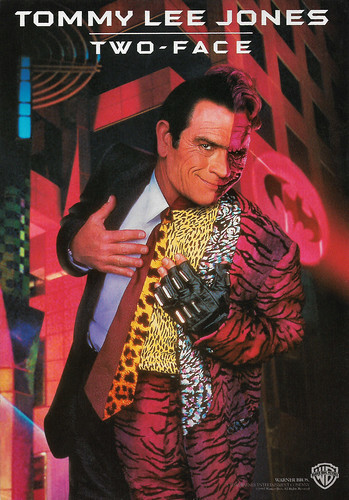
Belgian postcard by Boomerang Free Cards. Photo: Warner Bros. Tommy Lee Jones as Harvey Two-Face in Batman Forever (Joel Schumacher, 1995).
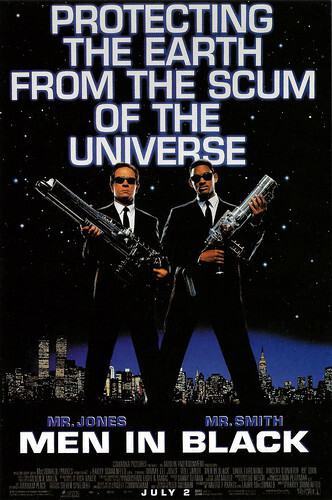
British postcard by Star Images, London, no. M.003. Photo: Columbia Pictures, 1997. Tommy Lee Jones and Will Smith in Men in Black (Barry Sonnenfeld, 1997). Caption: protecting the earth from the scum of the universe.
Sources: Hal Erickson (AllMovie), (IMDb), Wikipedia, and .

American postcard by Slow Dazzle Worldwide, no. 19 in a series of 16, no. 1621. Photo: DC Comics, 1995. Tommy Lee Jones as Harvey Two-Face in Batman Forever (Joel Schumacher, 1995). Caption: Half man, half madman, he's the ultimate dual personality. Two-Face is the former Gotham City district attorney Harvey Dent, who mistakenly blames Batman for an accident that left one side of his face grotesquely deformed. And now he's out to get Batman!
A strong, explosive, thoughtful actor who could handle supporting and leading roles
Tommy Lee Jones was born in 1946 in San Saba, Texas. He was the son of Lucille Marie (Scott), a police officer and beauty shop owner, and Clyde C. Jones, who worked on oil fields. Tommy himself worked in underwater construction and on an oil rig.
He attended St. Mark's School of Texas, a prestigious prep school for boys in Dallas, on a scholarship. On another scholarship, he attended Harvard University, where he roomed with future U.S. Vice President Al Gore. Though several of his less-knowledgeable fans have tended to dismiss Jones as a roughhewn redneck, the actor was equally at home on the polo fields (he's a champion player) as the oil fields. He received a B.A. in English literature and graduated cum laude from Harvard in 1969.
Following college, he moved to New York and began his stage career on Broadway in 'A Patriot for Me' with Maximilian Schell , which closed after 49 performances. In 1970, he appeared in his first film, Love Story (Arthur Hiller, 1970), listed way, way down the cast list as one of Ryan O'Neal's fraternity buddies. Interestingly enough, while Jones was at Harvard, he and roommate Gore provided the models for author Erich Segal while he was writing the character of Oliver, the book's (and film's) protagonist.
While living in New York, he continued to appear in various plays, both on- and off-Broadway: 'Fortune and Men's Eyes' (1969), Abe Burrows' 'Four on a Garden' (1971), 'Blue Boys' (1972), and 'Ulysses in Nighttown (1974). Between 1971 and 1975 he portrayed Dr. Mark Toland on the ABC soap opera, One Life to Live. Jones got his first film lead in the obscure Canadian film Eliza's Horoscope (Gordon Sheppard, 1975).
With his first wife, Kate Lardner, granddaughter of short-story writer/columnist Ring Lardner, and her two children from a previous marriage, he moved to Los Angeles. Jones gained national attention in 1977 when he was cast in the title role in the TV miniseries The Amazing Howard Hughes (William A. Graham, 1977). His resemblance to the American aviation pioneer and filmmaker - both vocally and visually - was positively uncanny.
In the cinema, he played an escaped convict hunted in the exploitation crime thriller Jackson County Jail (Michael Miller, 1976), a Vietnam veteran in the thriller Rolling Thunder (John Flynn, 1977), based on a story by Paul Schrader, an automobile mogul in the Harold Robbins drama The Betsy (Daniel Petrie, 1978) with Laurence Olivier , and opposite Faye Dunaway in the thriller Eyes of Laura Mars (Irvin Kershner, 1978), written by John Carpenter.
In 1980, Jones earned his first Golden Globe nomination for his portrayal of country singer Loretta Lynn's husband, Doolittle "Mooney" Lynn, in Coal Miner's Daughter (Michael Apted, 1980), starring Sissy Spacek. While working on the film Back Roads (Martin Ritt, 1981), he met and fell in love with Kimberlea Cloughley, whom he later married.
Jones won further acclaim and an Emmy for his startling performance as murderer Gary Gilmore in The Executioner's Song (Lawrence Schiller, 1982), based on the book by Norman Mailer. Maria Vitale at IMDb : "More roles in television, on stage, and in films garnered him a reputation as a strong, explosive, thoughtful actor who could handle supporting as well as leading roles." Jones spent the rest of the 1980s working in both television and film, doing his most notable work on such TV miniseries as Lonesome Dove (Simon Wincer, 1989), for which he earned another Emmy nomination.

British postcard by Star Images, London, no. M.002. Photo: Columbia Pictures, 1997. Tommy Lee Jones and Will Smith in Men in Black (Barry Sonnenfeld, 1997). Caption: Mr. Jones, Mr. Smith, protecting the earth from the scum of the universe.
A Golden Globe for his driven, starkly funny portrayal of a U.S. Marshal
It was not until the early 1990s that Tommy Lee Jones became a substantial figure in Hollywood, a position catalyzed by a Best Supporting Actor Oscar nomination for his role in Oliver Stone's epic political thriller JFK (1991) which examines the events leading to the assassination of John F. Kennedy in 1963 and the alleged cover-up through the eyes of former New Orleans district attorney Jim Garrison ( Kevin Costner ).
In 1993, Jones won both that award and a Golden Globe for his driven, starkly funny portrayal of U.S. Marshal Sam Gerard in The Fugitive (Andrew Davis, 1993), starring Harrison Ford. His subsequent work during the decade was prolific and enormously varied.
In 1994 alone, he could be seen as an insane prison warden in Natural Born Killers (Oliver Stone, 1994); titular baseball hero Ty Cobb in Cobb (Ron Shelton, 1994); a troubled army captain in Blue Sky (Tony Richardson, 1994); a wily federal attorney in the John Grisham adaptation The Client (Joel Schumacher, 1994); and a psychotic bomber in Blown Away (Stephen Hopkins, 1994) opposite Jeff Bridges.
Jones was also attached to a number of big-budget action films, hamming it up as the crazed Two-Face in Batman Forever (Joel Schumacher, 1995); donning sunglasses and an attitude to play special agent K in Men in Black (Barry Sonnenfeld, 1997); and reprising his Fugitive role for the film's sequel, U.S. Marshals (Stuart Baird, 1998).
The following year, he continued this trend, playing Ashley Judd's parole officer in the psychological thriller Double Jeopardy (Bruce Beresford, 1999). The late 1990s and millennial turnover found Jones' popularity soaring, and the distinguished actor continued to develop a successful comic screen persona in such films as Space Cowboys (Clint Eastwood, 2000) and Men in Black II (Barry Sonnenfeld, 2002), in addition to maintaining his dramatic clout with roles in such thrillers as Rules of Engagement (William Friedkin, 2000) and The Hunted (William Friedkin, 2003).

Dutch postcard by Boomerang. Photo: Amblin Entertainment / Columbia Pictures. Tommy Lee Jones and Will Smith in Men in Black II (Barry Sonnenfeld, 2002). Caption: Back in black.
The consummate corporate bad guy played with his trademark grit
2005 brought a comedic turn for Tommy Lee Jones who starred in the madcap comedy Man of the House (Stephen Herek, 2005) as a grizzled police officer who has to protect a house full of cheerleaders who witnessed a murder. Jones also took a stab at directing that year, helming and starring in the Neo-Western The Three Burials of Melquiades Estrada (Tommy Lee Jones, 2005). His performance won him the Best Actor Award at the 2005 Cannes Film Festival.
Jones appeared in the film adaptation of A Prairie Home Companion (Robert Altman, 2006), based on Garrison Keillor's long-running radio show. Hal Erickson at AllMovie : "The film's legendary director, much-loved source material, and all-star cast made the film a safe bet for the actor, who hadn't done much in the way of musical comedy. Jones played the consummate corporate bad guy with his trademark grit."
He headlined the Iraq war drama In the Valley of Elah (Paul Haggis, 2007). His work as the veteran father of a son who died in the war earned him strong reviews and an Oscar nomination for Best Actor. However, more people saw Jones' other film from that year, the Coen brothers adaptation of No Country for Old Men (Joel and Ethan Coen, 2007). His work as a middle-aged Texas sheriff haunted by the acts of the evil man he hunts earned him a Screen Actors Guild nomination for Best Supporting Actor.
The actor co-starred with Stanley Tucci and Neal McDonough in the blockbuster Captain America: The First Avenger (Joe Johnston, 2011) opposite Chris Evans, and reprised his role as a secret agent in Men in Black 3 (Barry Sonnenfeld, 2011). In 2012 he played a Congressman fighting to help Abraham Lincoln (Daniel Day-Lewis) end slavery in Lincoln (Steven Spielberg, 2012), a role that led to an Oscar nomination for Best Supporting Actor.
He most recently appeared in the Science-Fiction film Ad Astra (James Gray, 2019) starring Brad Pitt , and in the comedy The Comeback Trail (George Gallo, 2020) with Robert De Niro . Tommy Lee Jones and Kimberlea Cloughley have two children, Austin Leonard Jones (1982), and Victoria Jones (1991). After his divorce from Cloughley in 1996, he married Dawn Jones in 2001.

Belgian postcard by Boomerang Free Cards. Photo: Warner Bros. Tommy Lee Jones as Harvey Two-Face in Batman Forever (Joel Schumacher, 1995).

British postcard by Star Images, London, no. M.003. Photo: Columbia Pictures, 1997. Tommy Lee Jones and Will Smith in Men in Black (Barry Sonnenfeld, 1997). Caption: protecting the earth from the scum of the universe.
Sources: Hal Erickson (AllMovie), (IMDb), Wikipedia, and .
Published on October 23, 2021 22:00
October 22, 2021
Published by Armando Terzoli
During the late 1930s and 1940s, A. (Armando) Terzoli in Rome edited a large series of film star postcards with actors from the Italian sound cinema. The cards were printed by Stabilimenti Angeli in Terni. In and around Terni was then the heart of the Italian paper production. The photographers were the regular masters of that era: Bragaglia, Pesce, Gneme, Venturini, Ghergo, Bertazzini, Vaselli. Under his full name of Armando Terzoli, he edited a second series of Italian film star postcards, without the mentioning of Angeli. For this post, we selected sixteen postcards, thirteen of the first series and the final three of the second series.
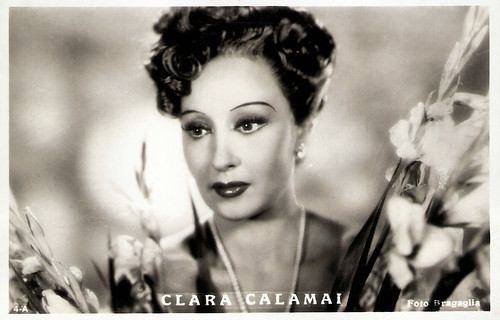
Italian postcard by St. b Angeli, Terni / A. Terzoli, Roma, no. 4.A. Photo: Bragaglia.
Though she acted in many light entertainment films, Clara Calamai 's (1909-1998) most famous role will for always be femme fatale Giovanna in Luchino Visconti's steamy (proto-)neorealist film Ossessione (1943).
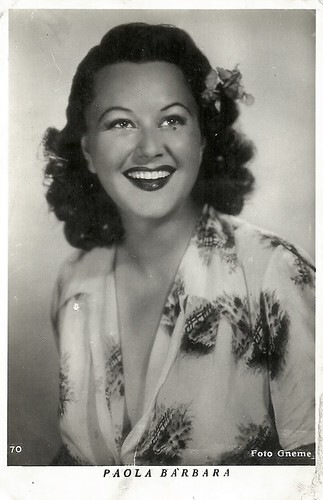
Italian postcard by A. Terzoli, Roma / Stabilimenti Angeli, Terni, no. 70. Photo: Gneme.
Paola Barbara (1912-1989) was an Italian actress who acted in over 60 films but also worked on stage and for television. She is best known for the film La peccatrice (1940) by Amleto Palermi.
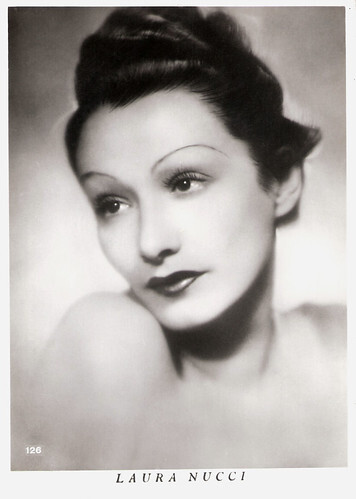
Italian postcard by A. Terzoli, Roma / Stabilimenti Angeli, Terni, no. 126.
Italian actress Laura Nucci (1913-1994) was one of the stars of Italian cinema of the 1930s and 1940s. Between 1930 and 1989, she appeared in more than 60 films and TV series.
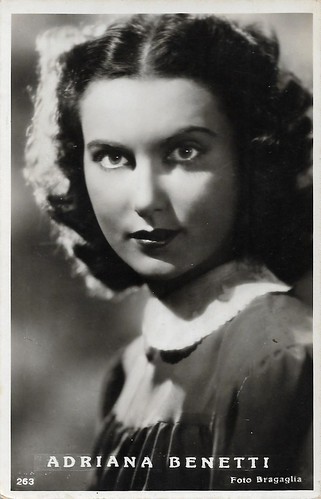
Italian postcard by A. Terzoli, Roma / Stabilimenti Angeli, Terni, no. 263. Photo: Bragaglia.
Adriana Benetti (1919–2016) was an Italian actress, who peaked in the 1940s in films such as Teresa Venerdí (1941) and Quattro passi fra le nuvole (1942).
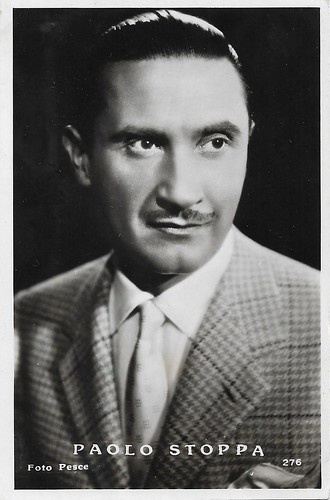
Italian postcard by A. Terzoli, Roma / Stabilimenti Angeli, Terni, no. 276. Photo: Pesce.
Italian character actor Paolo Stoppa (1906–1988) is best known for his stage work with director Luchino Visconti. In a career of more than 50 years, he also appeared in such cinema classics as Miracolo a Milano (1951), Il Gattopardo (1962), and Once Upon a Time in the West (1968).
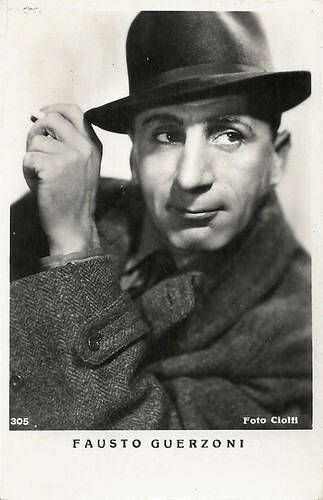
Italian postcard by A. Terzoli, Roma / Stabilimenti Angeli, Terni, no. 305. Photo: Ciolfi.
Fausto Guerzoni (1904-1967) began his career as a young comic actor in avant-garde and variety theatre. He was discovered by Mario Camerini, who let him debut in the film Darò un milione/I'll give you a million (1935). Thus he began a career in over a hundred films.
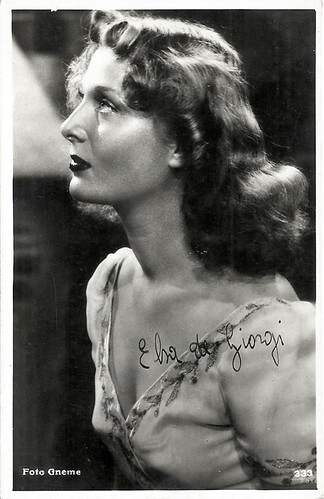
Italian postcard by A. Terzoli, Roma / Stabilimenti Angeli, Terni, no. 333 Photo: Gneme.
Italian stage and screen actress Elsa De Giorgi (1914-1997) worked also as a director and set designer and was a successful novelist. She had a prolific career in the Italian cinema under Mussolini, and after the war, she worked on stage with Luchino Visconti and Giorgi Strehler and in films by Pier Paolo Pasolini. But she is now best remembered for her extramarital affair with author Italo Calvino.
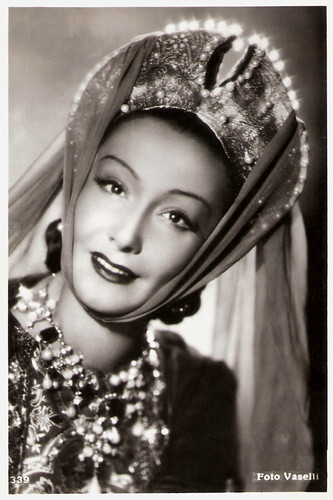
Italian postcard by A. Terzoli, Roma / Stabilimenti Angeli, Terni, no. 339. Photo: Vaselli. Laura Nucci in Rita da Cascia (Antonio Leonviola, 1943).
Italian actress Laura Nucci (1913-1994) was one of the stars of the Fascist era. Between 1930 and 1989, she appeared in more than 60 films and TV series.
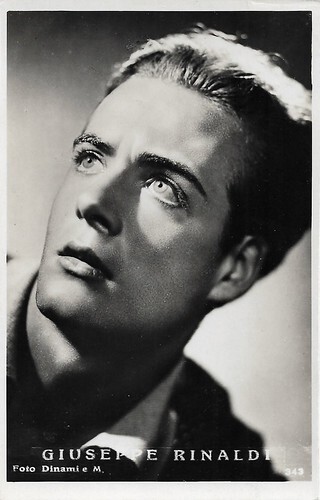
Italian postcard by A. Terzoli, Roma / Stabilimenti Angeli, Terni, no. 343. Photo: Dinami e M.
Giuseppe Rinaldi (1919-2007) had his first supporting part at the age of 20 in Mario Camerini's I grandi magazzini (1939). His first major part was opposite Maria Mercader in Il prigioniero di Santa Cruz (Carlo Ludovico Bragaglia, 1941). During the war years, Rinaldi had several major supporting parts in Italian cinema, both in drama and comedy. After the war, he acted as the engineer in Aldo Fabrizi's Emigrantes (1949). In parallel with his career as an actor, Rinaldi dedicated his life to dubbing films.
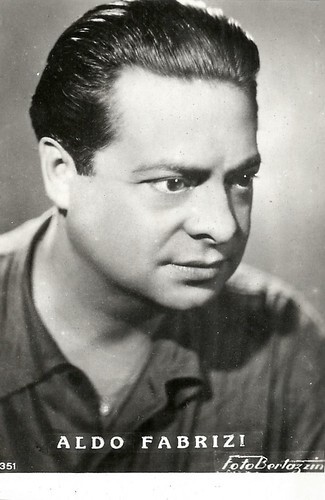
Italian postcard by A. Terzoli, Roma / Stabilimenti Angeli, Terni, no. 351. Photo: Bertazzini.
Aldo Fabrizi (1905-1990) was an Italian actor, screenwriter, and director. Aldo Fabrizi was one of the most important figures in post-war Italian cinema. With his receding hairline and round silhouette, he imposed a character typical of a sympathetic and naive Roman, which won him great success in the Italian peninsula. But his talent far exceeded the mere register of comedy, as his tragic role as a resistant priest in Roma, città aperta/Open City (Roberto Rossellini, 1945) proved.
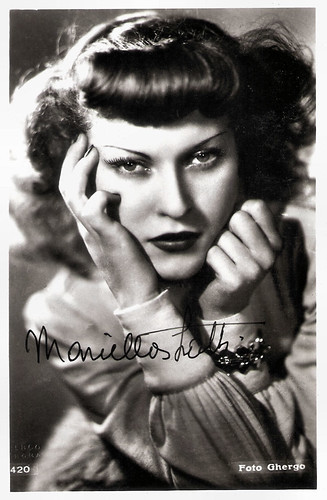
Italian postcard by A. Terzoli, Roma / Stabilimenti Angeli, Terni, no. 420. Photo: Ghergo.
Blonde Italian film actress Mariella Lotti (1921–2006) played leading ladies in a number of Fascist-era and post-war films. The refined beauty quickly became one of the most popular Italian divas of the 1940s.
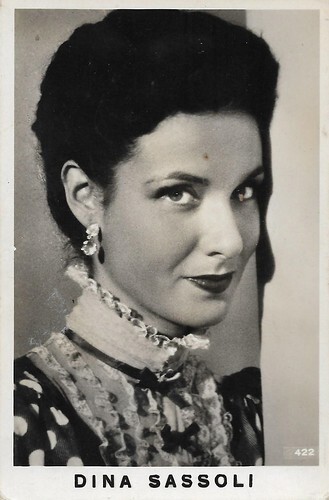
Italian postcard by A. Terzoli, Roma / Stabilimenti Angeli, Terni, no. 422. Dina Sassoli in Colpi di timone (Gennaro Righelli, 1942).
Dina Sassoli (1920-2008) was an Italian stage and screen actress, who broke through with the film I promessi sposi (Mario Camerini, 1941), but her success came with a twist. She had married a young journalist, who was considered antifascist by the government. In 1942, he disappeared. Devastated, Sassoli almost gave up her career. However, in the war years, she played several leads in films as Nessuno torna indietro/None came back (Alessandro Blasetti, 1943, released 1945). She also starred in memorable films from the postwar era such as Un giorno nella vita/A day in the life (1946), Umanità/Humanity (1946), and Il mulino del Po/The Mill on the Po (1948), as the sister of Jacques Sernas.
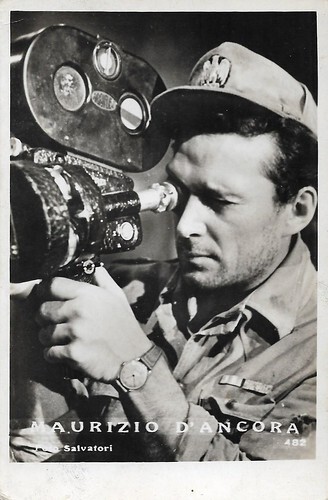
Italian postcard by A. Terzoli, Roma / Stabilimenti Angeli, Terni, no. 482. Photo: Salvatori. The card may refer to the war propaganda film Inviati speciali (Romolo Marcellini, 1943) in which D'Ancora plays a camera operator.
Maurizio D'Ancora (1912-1983) was discovered by the Danish film director Alfred Lind, who was looking for a new face, to give him the male role in the silent film Ragazze non scherzate/Girls, be serious (1929) alongside the diva Leda Gloria. In 1929 Mario Camerini chose him to star opposite Käthe von Nagy as the suicidal poor couple in the almost proto-Antonioni film Rotaie (1931). These films were the beginning of a successful acting career, which he would pursue until the end of World War II.

Italian postcard by Armando Terzoli, Roma, no. 532. Photo: Pesce. Clara Calamai in La Cena delle Beffe/The Jesters' Supper (Alessandro Blasetti, 1942).
Though she acted in many light entertainment films, Clara Calamai 's (1909-1998) most famous role will always be femme fatale Giovanna in Luchino Visconti's steamy (proto-)neorealist film Ossessione/Obsession (1943).
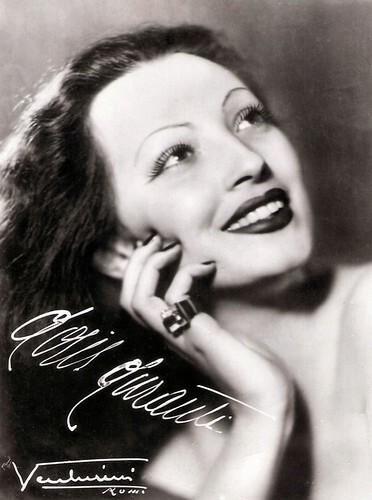
Italian postcard by Armando Terzoli, Roma. Photo: Venturini, Roma.
Italian actress Doris Duranti (1917-1995) was a major star of the Italian cinema of the late 1930s and early 1940s and the main competitor of Clara Calamai. Duranti was also the lover of a notorious fascist.
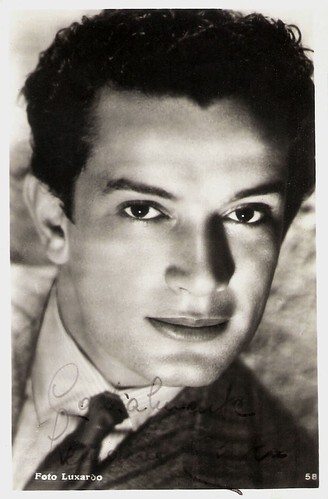
Italian postcard by Armando Terzoli, Roma, no. 58. Photo: Luxardo.
Leonardo Cortese (1916-1984) was a matinee idol of the Italian cinema of the 1940s. He starred in such films as Sissignora (1941) and Un garibaldino al convento (Vittorio De Sica, 1942). After the war, he started directing, first films and later on rather focusing on television.

Italian postcard by St. b Angeli, Terni / A. Terzoli, Roma, no. 4.A. Photo: Bragaglia.
Though she acted in many light entertainment films, Clara Calamai 's (1909-1998) most famous role will for always be femme fatale Giovanna in Luchino Visconti's steamy (proto-)neorealist film Ossessione (1943).

Italian postcard by A. Terzoli, Roma / Stabilimenti Angeli, Terni, no. 70. Photo: Gneme.
Paola Barbara (1912-1989) was an Italian actress who acted in over 60 films but also worked on stage and for television. She is best known for the film La peccatrice (1940) by Amleto Palermi.

Italian postcard by A. Terzoli, Roma / Stabilimenti Angeli, Terni, no. 126.
Italian actress Laura Nucci (1913-1994) was one of the stars of Italian cinema of the 1930s and 1940s. Between 1930 and 1989, she appeared in more than 60 films and TV series.

Italian postcard by A. Terzoli, Roma / Stabilimenti Angeli, Terni, no. 263. Photo: Bragaglia.
Adriana Benetti (1919–2016) was an Italian actress, who peaked in the 1940s in films such as Teresa Venerdí (1941) and Quattro passi fra le nuvole (1942).

Italian postcard by A. Terzoli, Roma / Stabilimenti Angeli, Terni, no. 276. Photo: Pesce.
Italian character actor Paolo Stoppa (1906–1988) is best known for his stage work with director Luchino Visconti. In a career of more than 50 years, he also appeared in such cinema classics as Miracolo a Milano (1951), Il Gattopardo (1962), and Once Upon a Time in the West (1968).

Italian postcard by A. Terzoli, Roma / Stabilimenti Angeli, Terni, no. 305. Photo: Ciolfi.
Fausto Guerzoni (1904-1967) began his career as a young comic actor in avant-garde and variety theatre. He was discovered by Mario Camerini, who let him debut in the film Darò un milione/I'll give you a million (1935). Thus he began a career in over a hundred films.

Italian postcard by A. Terzoli, Roma / Stabilimenti Angeli, Terni, no. 333 Photo: Gneme.
Italian stage and screen actress Elsa De Giorgi (1914-1997) worked also as a director and set designer and was a successful novelist. She had a prolific career in the Italian cinema under Mussolini, and after the war, she worked on stage with Luchino Visconti and Giorgi Strehler and in films by Pier Paolo Pasolini. But she is now best remembered for her extramarital affair with author Italo Calvino.

Italian postcard by A. Terzoli, Roma / Stabilimenti Angeli, Terni, no. 339. Photo: Vaselli. Laura Nucci in Rita da Cascia (Antonio Leonviola, 1943).
Italian actress Laura Nucci (1913-1994) was one of the stars of the Fascist era. Between 1930 and 1989, she appeared in more than 60 films and TV series.

Italian postcard by A. Terzoli, Roma / Stabilimenti Angeli, Terni, no. 343. Photo: Dinami e M.
Giuseppe Rinaldi (1919-2007) had his first supporting part at the age of 20 in Mario Camerini's I grandi magazzini (1939). His first major part was opposite Maria Mercader in Il prigioniero di Santa Cruz (Carlo Ludovico Bragaglia, 1941). During the war years, Rinaldi had several major supporting parts in Italian cinema, both in drama and comedy. After the war, he acted as the engineer in Aldo Fabrizi's Emigrantes (1949). In parallel with his career as an actor, Rinaldi dedicated his life to dubbing films.

Italian postcard by A. Terzoli, Roma / Stabilimenti Angeli, Terni, no. 351. Photo: Bertazzini.
Aldo Fabrizi (1905-1990) was an Italian actor, screenwriter, and director. Aldo Fabrizi was one of the most important figures in post-war Italian cinema. With his receding hairline and round silhouette, he imposed a character typical of a sympathetic and naive Roman, which won him great success in the Italian peninsula. But his talent far exceeded the mere register of comedy, as his tragic role as a resistant priest in Roma, città aperta/Open City (Roberto Rossellini, 1945) proved.

Italian postcard by A. Terzoli, Roma / Stabilimenti Angeli, Terni, no. 420. Photo: Ghergo.
Blonde Italian film actress Mariella Lotti (1921–2006) played leading ladies in a number of Fascist-era and post-war films. The refined beauty quickly became one of the most popular Italian divas of the 1940s.

Italian postcard by A. Terzoli, Roma / Stabilimenti Angeli, Terni, no. 422. Dina Sassoli in Colpi di timone (Gennaro Righelli, 1942).
Dina Sassoli (1920-2008) was an Italian stage and screen actress, who broke through with the film I promessi sposi (Mario Camerini, 1941), but her success came with a twist. She had married a young journalist, who was considered antifascist by the government. In 1942, he disappeared. Devastated, Sassoli almost gave up her career. However, in the war years, she played several leads in films as Nessuno torna indietro/None came back (Alessandro Blasetti, 1943, released 1945). She also starred in memorable films from the postwar era such as Un giorno nella vita/A day in the life (1946), Umanità/Humanity (1946), and Il mulino del Po/The Mill on the Po (1948), as the sister of Jacques Sernas.

Italian postcard by A. Terzoli, Roma / Stabilimenti Angeli, Terni, no. 482. Photo: Salvatori. The card may refer to the war propaganda film Inviati speciali (Romolo Marcellini, 1943) in which D'Ancora plays a camera operator.
Maurizio D'Ancora (1912-1983) was discovered by the Danish film director Alfred Lind, who was looking for a new face, to give him the male role in the silent film Ragazze non scherzate/Girls, be serious (1929) alongside the diva Leda Gloria. In 1929 Mario Camerini chose him to star opposite Käthe von Nagy as the suicidal poor couple in the almost proto-Antonioni film Rotaie (1931). These films were the beginning of a successful acting career, which he would pursue until the end of World War II.

Italian postcard by Armando Terzoli, Roma, no. 532. Photo: Pesce. Clara Calamai in La Cena delle Beffe/The Jesters' Supper (Alessandro Blasetti, 1942).
Though she acted in many light entertainment films, Clara Calamai 's (1909-1998) most famous role will always be femme fatale Giovanna in Luchino Visconti's steamy (proto-)neorealist film Ossessione/Obsession (1943).

Italian postcard by Armando Terzoli, Roma. Photo: Venturini, Roma.
Italian actress Doris Duranti (1917-1995) was a major star of the Italian cinema of the late 1930s and early 1940s and the main competitor of Clara Calamai. Duranti was also the lover of a notorious fascist.

Italian postcard by Armando Terzoli, Roma, no. 58. Photo: Luxardo.
Leonardo Cortese (1916-1984) was a matinee idol of the Italian cinema of the 1940s. He starred in such films as Sissignora (1941) and Un garibaldino al convento (Vittorio De Sica, 1942). After the war, he started directing, first films and later on rather focusing on television.
Published on October 22, 2021 22:00
October 21, 2021
The Four Hundred Tricks of the Devil
Les Quatre Cents Coups du diable (The Four Hundred Tricks of the Devil) was a 'grande féerie', first performed on 23 December 1905 at the Théâtre du Châtelet in Paris. Ivo Blom found nine vintage postcards of this remarkable stage spectacle. The 'féerie', sometimes translated as 'fairy play', was a French theatrical genre known for fantasy plots and spectacular visuals, including lavish scenery and mechanically worked stage effects. The féerie blended music, dancing, pantomime, and acrobatics, as well as magical transformations created by designers and stage technicians. This genre was immensely popular in France throughout the nineteenth century, influencing the development of burlesque, musical comedy, and film. With his 1899 film version of Cinderella, Georges Méliès brought the féerie into the newly developing world of cinema. Les Quatre Cents Coups du diable consisted of four acts and 34 'tableaux' (sequences): 32 sequences by Victor de Cottens and Victor Darlay plus two filmic interludes, Le Voyage dans l'éspace and Le Cyclone, by Méliès. The Châtelet extravaganza was very successful and was performed 216 times in the 1905-1906 season. Soon after, Georges Méliès decided to build Le Voyage dans l'éspace into a freestanding silent film: Les quatre cents farces du diable/The Merry Frolics of Satan (1906) The new material was made at least six months after the originally filmed sequences, with different actors, including Méliès himself as Mephistopheles.

French postcard by Collection du "Photo-Programme", Paris. Caption: Théâtre du Châtelet. Les 400 Coups du Diable, grande féerie en 34 tableaux, de Messieurs V. [Victor] de Cottens et V. [Victor] Darlay. 1er Tableau, Le Conseil des Génies.
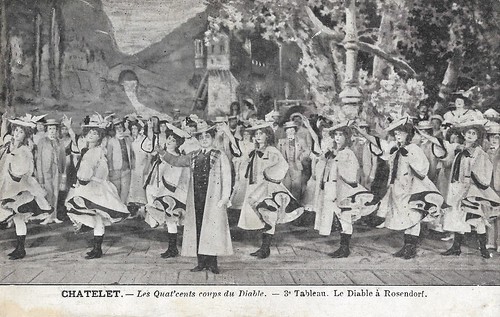
French postcard by Collection du "Photo-Programme", Paris. Caption: Théâtre du Châtelet. Les 400 Coups du Diable, grande féerie en 34 tableaux, de Messieurs V. [Victor] de Cottens et V. [Victor] Darlay. 3e tableau. Le Diable à Rosendorf.
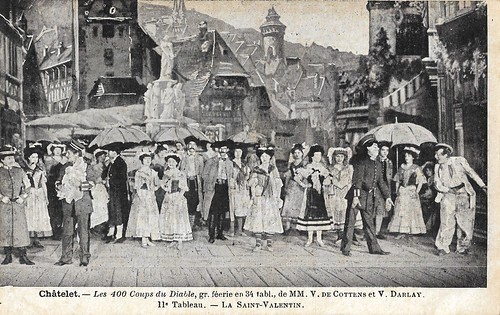
French postcard by Collection du "Photo-Programme", Paris. Caption: Théâtre du Châtelet. Les 400 Coups du Diable, grande féerie en 34 tableaux, de Messieurs V. [Victor] de Cottens et V. [Victor] Darlay. 11e Tableau. La Saint-Valentin.
Acte premier
1er Tableau: Le conseil des Génies (Décor de M. Amable).
2e ---- : Le Voyage dans l’espace. Scènes cinématographiques par M. Méliès.
3e ---- : Le Diable à Rosendorf. (Les Baigneurs et les Baigneuses). Divertissement réglé par Mlle. Stichel.
4e ---- : Une place qui se promène (Panorama mouvant).
5e ---- : La Montagne des Rhododendrons.
6e ---- : La Grotte du Sorcier.
7e ---- : Le Laboratoire d’Alcofrisbas (Décors de M. Amable).
8e ---- : Le Jardin des Hespérides. Divertissement réglé par Mlle. Stichel, dansé par Mlle Lucie Maire, danseuse étoile (Pomone), Mlles Forbacco, Lampo, Moris, Blanchard, secondes danseuses, et les dames du corps de ballet.
9e ---- : Le Jardin de Lutèce. Divertissement réglé par Mlle Stichel (Décors de MM. Jambon et Bailly).
Acte II
10e Tableau: Le Goûter de Marguerite.
11e ---- : Le Marché de Saint-Valentin (Les Valentins et les Valentines. Divertissement réglé par Mlle Stichel, Décors de MM. Jambon et Bailly).
12e ---- : Le Cyclone. Scènes cinématographiques de M. Méliès.
13e ---- : Paris en l’an 2000.
14e ---- : La navigation aérienne.
15e ---- : L’Auberge du Lapin sauté. Grande pantomime, réglée par M. James Price.
16e ---- : Les Pompiers de l’Amour. Pantomime par 20 enfants et 4 petites Anglaises (Décors de MM. Jambon et Bailly).
17e ---- : Les Pilules du Diable.
18e ---- : Les Bords du Styx.
19e ---- : Les Gnomes et les Damnés.
20e ---- : L’Enfer. Diables, diablesses, diablotins, 200 personnes (Décors de M. Amable).

French postcard by Collection du "Photo-Programme", Paris. Caption: Théâtre du Châtelet. Les 400 Coups du Diable, grande féerie en 34 tableaux, de Messieurs V. [Victor] de Cottens et V. [Victor] Darlay. 16e Tableau. Les Pompiers de l'Amour.
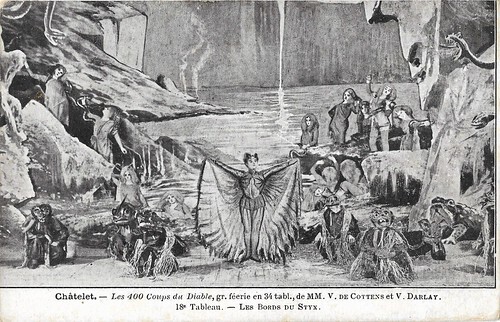
French postcard by Collection du "Photo-Programme", Paris. Caption: Théâtre du Châtelet. Les 400 Coups du Diable, grande féerie en 34 tableaux, de Messieurs V. [Victor] de Cottens et V. [Victor] Darlay. 18e Tableau. Les Bords du Styx.
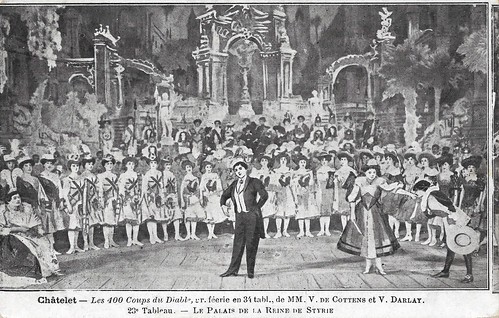
French postcard by Collection du "Photo-Programme", Paris. Caption: Théâtre du Châtelet. Les 400 Coups du Diable, grande féerie en 34 tableaux, de Messieurs V. [Victor] de Cottens et V. [Victor] Darlay. 23e Tableau. Le Palais de la Reine de Styrie.
Acte III
21e Tableau: Le Lac bleu.
22e ---- : Les Eaux diaboliques (Décors de M. Amable). Fontaines lumineuses, sous la direction de M. Hagedorn.
23e ---- : Le Palais de la Reine de Styrie (Pages, Dames de la Cour, Seigneurs, Hérauts d’armes, Chambellans, Gardes d’honneur etc.).
24e ---- : Les Ambassades. Grand défilé dansant. Ballet réglé par Mlle Stichel, dansé par Mlle Lucie Maire, danseuse étoile (Le Protocole), les Ambassades de France, Russie, Italie, Angleterre, Espagne, Pays-Bas (50 danseurs, 24 enfants, 100 marcheuses, 150 figurants).
25e ---- : La Pharmacie endiablée.
26e ---- : Le Château des Carpathes. Manœuvre militaire par les dames du corps de ballet.
27e ---- : La Batterie infernale. (Manœuvre de canon, par les Ping Pong’s).
28e ---- : L’Attaque des Remparts.
29e ---- : L’Assaut.
30e ---- : Après la Bataille (Panorama mouvant).
31e ---- : La Revue de cent mille hommes. Cuirassiers d’honneur, hussards rouges, lanciers bleus, dragons blancs, artilleurs, voltigeurs, chasseurs à pied, grognards, gardes d’honneur, porte-étendards, musiciens, seigneurs, pages, etc. (Décors de M. Amable).
Acte IV
32e Tableau: L’Ermitage de Saint-Frusquin.
33e ---- : Le Mur enchanté.
34e ---- : Les Ports-Veines. Apothéose. Divertissement réglé par Mlle Stichel. (Les Petits Cochons, Le Sou-Percé, Les Amulettes, La Main de Fathma, Les Eléphants blancs, Les Petits Bossus, Le Trèfle à 4 feuilles, Le Fer à Cheval, L’Araignée d’or, Le No. 13, Le Corail, Le Jeu de Cartes, La Feuille d’Or). (Décors de MM. Jambon et Bailly).

French postcard by Collection du "Photo-Programme", Paris. Caption: Théâtre du Châtelet. Les 400 Coups du Diable, grande féerie en 34 tableaux, de Messieurs V. [Victor] de Cottens et V. [Victor] Darlay. 25e Tableau. La Pharmacie endiablée.

French postcard by Collection du "Photo-Programme", Paris. Caption: Théâtre du Châtelet. Les 400 Coups du Diable, grande féerie en 34 tableaux, de Messieurs V. [Victor] de Cottens et V. [Victor] Darlay. 30e tableau. L'Ermitage de Saint-Frusquin.
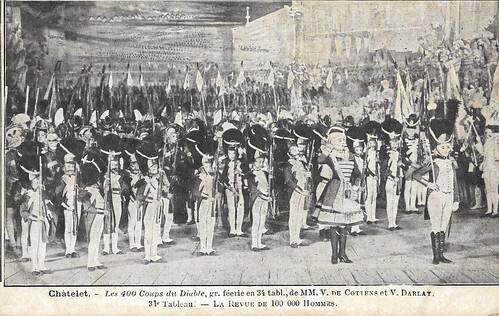
French postcard by Collection du "Photo-Programme", Paris. Caption: Théâtre du Châtelet. Les 400 Coups du Diable, grande féerie en 34 tableaux, de Messieurs V. [Victor] de Cottens et V. [Victor] Darlay. 31e tableau. La Revue de 100 000 Hommes.
Sources: Frank Kessler (The Féerie Between Stage and Screen, 2012) and Wikipedia. With thanks to Frank Kessler for the list of the tableaux.

French postcard by Collection du "Photo-Programme", Paris. Caption: Théâtre du Châtelet. Les 400 Coups du Diable, grande féerie en 34 tableaux, de Messieurs V. [Victor] de Cottens et V. [Victor] Darlay. 1er Tableau, Le Conseil des Génies.

French postcard by Collection du "Photo-Programme", Paris. Caption: Théâtre du Châtelet. Les 400 Coups du Diable, grande féerie en 34 tableaux, de Messieurs V. [Victor] de Cottens et V. [Victor] Darlay. 3e tableau. Le Diable à Rosendorf.

French postcard by Collection du "Photo-Programme", Paris. Caption: Théâtre du Châtelet. Les 400 Coups du Diable, grande féerie en 34 tableaux, de Messieurs V. [Victor] de Cottens et V. [Victor] Darlay. 11e Tableau. La Saint-Valentin.
Acte premier
1er Tableau: Le conseil des Génies (Décor de M. Amable).
2e ---- : Le Voyage dans l’espace. Scènes cinématographiques par M. Méliès.
3e ---- : Le Diable à Rosendorf. (Les Baigneurs et les Baigneuses). Divertissement réglé par Mlle. Stichel.
4e ---- : Une place qui se promène (Panorama mouvant).
5e ---- : La Montagne des Rhododendrons.
6e ---- : La Grotte du Sorcier.
7e ---- : Le Laboratoire d’Alcofrisbas (Décors de M. Amable).
8e ---- : Le Jardin des Hespérides. Divertissement réglé par Mlle. Stichel, dansé par Mlle Lucie Maire, danseuse étoile (Pomone), Mlles Forbacco, Lampo, Moris, Blanchard, secondes danseuses, et les dames du corps de ballet.
9e ---- : Le Jardin de Lutèce. Divertissement réglé par Mlle Stichel (Décors de MM. Jambon et Bailly).
Acte II
10e Tableau: Le Goûter de Marguerite.
11e ---- : Le Marché de Saint-Valentin (Les Valentins et les Valentines. Divertissement réglé par Mlle Stichel, Décors de MM. Jambon et Bailly).
12e ---- : Le Cyclone. Scènes cinématographiques de M. Méliès.
13e ---- : Paris en l’an 2000.
14e ---- : La navigation aérienne.
15e ---- : L’Auberge du Lapin sauté. Grande pantomime, réglée par M. James Price.
16e ---- : Les Pompiers de l’Amour. Pantomime par 20 enfants et 4 petites Anglaises (Décors de MM. Jambon et Bailly).
17e ---- : Les Pilules du Diable.
18e ---- : Les Bords du Styx.
19e ---- : Les Gnomes et les Damnés.
20e ---- : L’Enfer. Diables, diablesses, diablotins, 200 personnes (Décors de M. Amable).

French postcard by Collection du "Photo-Programme", Paris. Caption: Théâtre du Châtelet. Les 400 Coups du Diable, grande féerie en 34 tableaux, de Messieurs V. [Victor] de Cottens et V. [Victor] Darlay. 16e Tableau. Les Pompiers de l'Amour.

French postcard by Collection du "Photo-Programme", Paris. Caption: Théâtre du Châtelet. Les 400 Coups du Diable, grande féerie en 34 tableaux, de Messieurs V. [Victor] de Cottens et V. [Victor] Darlay. 18e Tableau. Les Bords du Styx.

French postcard by Collection du "Photo-Programme", Paris. Caption: Théâtre du Châtelet. Les 400 Coups du Diable, grande féerie en 34 tableaux, de Messieurs V. [Victor] de Cottens et V. [Victor] Darlay. 23e Tableau. Le Palais de la Reine de Styrie.
Acte III
21e Tableau: Le Lac bleu.
22e ---- : Les Eaux diaboliques (Décors de M. Amable). Fontaines lumineuses, sous la direction de M. Hagedorn.
23e ---- : Le Palais de la Reine de Styrie (Pages, Dames de la Cour, Seigneurs, Hérauts d’armes, Chambellans, Gardes d’honneur etc.).
24e ---- : Les Ambassades. Grand défilé dansant. Ballet réglé par Mlle Stichel, dansé par Mlle Lucie Maire, danseuse étoile (Le Protocole), les Ambassades de France, Russie, Italie, Angleterre, Espagne, Pays-Bas (50 danseurs, 24 enfants, 100 marcheuses, 150 figurants).
25e ---- : La Pharmacie endiablée.
26e ---- : Le Château des Carpathes. Manœuvre militaire par les dames du corps de ballet.
27e ---- : La Batterie infernale. (Manœuvre de canon, par les Ping Pong’s).
28e ---- : L’Attaque des Remparts.
29e ---- : L’Assaut.
30e ---- : Après la Bataille (Panorama mouvant).
31e ---- : La Revue de cent mille hommes. Cuirassiers d’honneur, hussards rouges, lanciers bleus, dragons blancs, artilleurs, voltigeurs, chasseurs à pied, grognards, gardes d’honneur, porte-étendards, musiciens, seigneurs, pages, etc. (Décors de M. Amable).
Acte IV
32e Tableau: L’Ermitage de Saint-Frusquin.
33e ---- : Le Mur enchanté.
34e ---- : Les Ports-Veines. Apothéose. Divertissement réglé par Mlle Stichel. (Les Petits Cochons, Le Sou-Percé, Les Amulettes, La Main de Fathma, Les Eléphants blancs, Les Petits Bossus, Le Trèfle à 4 feuilles, Le Fer à Cheval, L’Araignée d’or, Le No. 13, Le Corail, Le Jeu de Cartes, La Feuille d’Or). (Décors de MM. Jambon et Bailly).

French postcard by Collection du "Photo-Programme", Paris. Caption: Théâtre du Châtelet. Les 400 Coups du Diable, grande féerie en 34 tableaux, de Messieurs V. [Victor] de Cottens et V. [Victor] Darlay. 25e Tableau. La Pharmacie endiablée.

French postcard by Collection du "Photo-Programme", Paris. Caption: Théâtre du Châtelet. Les 400 Coups du Diable, grande féerie en 34 tableaux, de Messieurs V. [Victor] de Cottens et V. [Victor] Darlay. 30e tableau. L'Ermitage de Saint-Frusquin.

French postcard by Collection du "Photo-Programme", Paris. Caption: Théâtre du Châtelet. Les 400 Coups du Diable, grande féerie en 34 tableaux, de Messieurs V. [Victor] de Cottens et V. [Victor] Darlay. 31e tableau. La Revue de 100 000 Hommes.
Sources: Frank Kessler (The Féerie Between Stage and Screen, 2012) and Wikipedia. With thanks to Frank Kessler for the list of the tableaux.
Published on October 21, 2021 22:00
October 20, 2021
William Boyd
American film actor William Boyd (1895-1972) with his expressive blue eyes and prematurely silver-gray hair was a sought-after leading man of the silent movie era. He is now best known for his later parts in Westerns and is known primarily as the performer of the cowboy Hopalong Cassidy in the eponymous film and TV series.
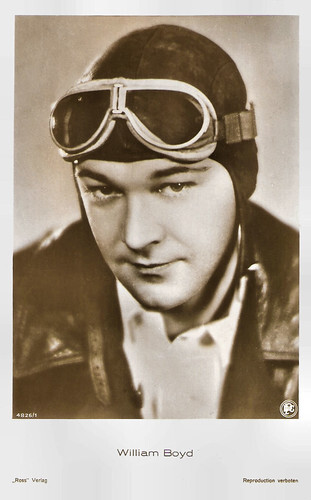
German postcard by Ross Verlag, no. 4826/1,1929-1930. Photo: PDC. William Boyd in The Flying Fool (Tay Garnett, 1929).
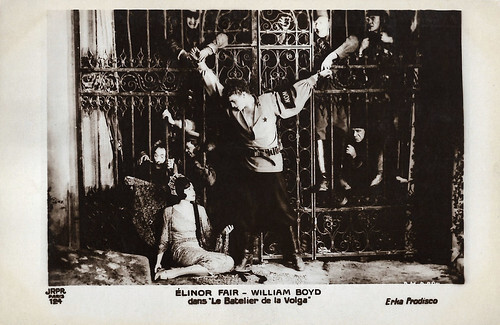
French postcard by JRPR, Paris, no. 124. Photo: Erka Prodisco. Elinor Fair and William Boyd in The Volga Boatman (Cecil B. DeMille, 1926).
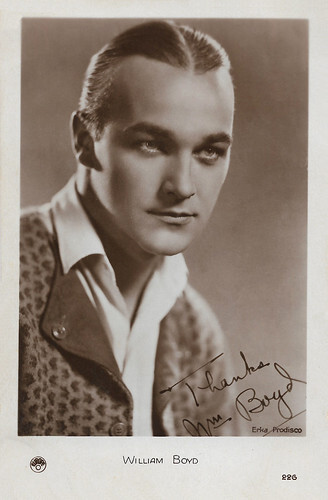
French postcard by Europe. no. 226. Photo: Erka Prodisco.
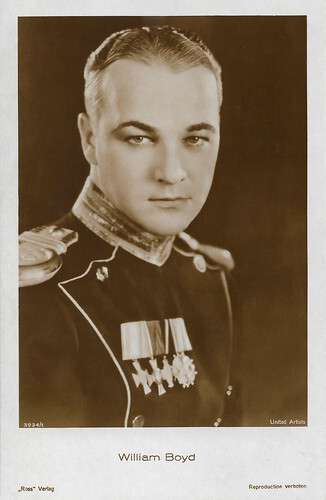
German postcard by Ross Verlag, no. 3934/1, 1928-1929. Photo: United Artists. William Boyd in Lady of the Pavements (D.W. Griffith, 1929).
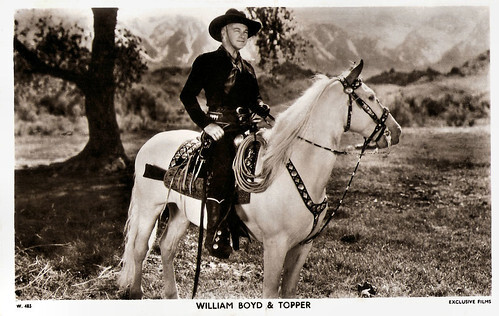
British postcard in the Picturegoer Series, London, no. W.485. Photo: Exclusive Films. Caption: William Boyd & Topper.
Easy charm, charisma, and intense good-looks
William Boyd was born in 1895 in Hendrysburg, Ohio, and reared in Cambridge, Ohio, and lived in Tulsa from 1909 to 1913. He was the son of a day laborer, Charles William Boyd, and his wife, the former Lida Wilkens (aka Lyda). Following his father's death, he moved to California and worked as an orange picker, surveyor, tool dresser, and auto salesman.
During World War I, he enlisted in the army but was exempt from military service because of a "weak heart". In 1918, Boyd arrived in Hollywood and found work as an extra in Why Change Your Wife? (Cecil B. De Mille, 1920) and other films. He saved Cecil B. DeMille 's then-favorite actress Julia Faye an awkward situation during the shooting of Saturday Night (1922) when her bathing suit suddenly sprang open. Thanks to this, DeMille would give Boyd his chance a few years after.
Boyd had his definite breakthrough as Jack Moreland in The Road to Yesterday (Cecil B. DeMille, 1925), also with Joseph Schildkraut , Jetta Goudal , and Vera Reynolds. Critics praised Boyd's performance - as the virile minister Jack who doesn't mind kissing flapper Bess (Vera Reynolds) and knows to use his fists when necessary - while moviegoers loved his easy charm, charisma, and intense good-looks.
Due to his growing popularity, DeMille soon cast Boyd as the male lead in the highly successful silent drama, The Volga Boatman (1926). In Tsarist Russia, the Volga boatman Feodor (Boyd) meets Prince Dimitri ( Victor Varconi ) and his fiancée Vera (Elinor Fair). During the October Revolution, he meets Vera again when he has become a Red Army officer. He receives the order to shoot her but is impressed with her bravery and saves her. Both flee but then have to face the power of Dimitri.
After this film, Boyd had definitely become a matinee idol. He began earning an annual salary of $100,000. He acted in DeMille's extravaganza The King of Kings (Cecil B. DeMille, 1927) in which he played Simon of Cyrene, helping Jesus carry the cross, and DeMille's Skyscraper (Cecil B. DeMille, 1928). He then appeared in D.W. Griffith 's Lady of the Pavements (1929) opposite Lupe Velez and Jetta Goudal . Griffith reshot the film to include a couple of musical numbers, making it a part-talkie.
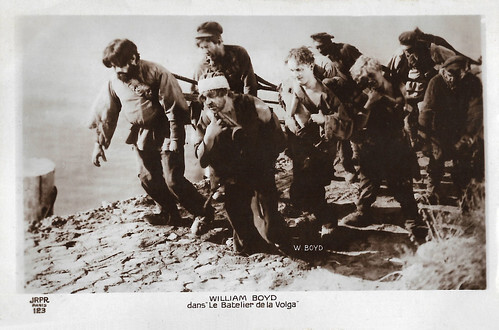
French postcard by JRPR, Paris, no. 123. Photo: Erka Prodisco. William Boyd in The Volga Boatman (Cecil B. DeMille, 1926). This image is a pictorial citation of the famous painting 'Volga Boatmen/ Barge Haulers on the Volga' (1870-1873) by Ilia Efimovich Repin (1844-1930).
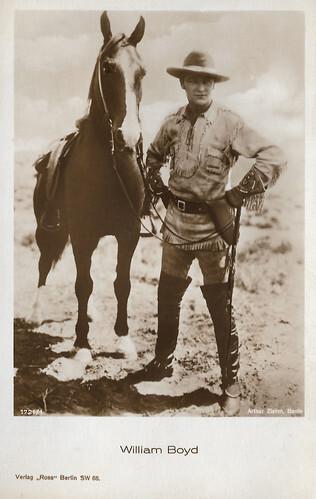
German postcard by Ross Verlag, no. 1721/1, 1927-1928. Photo: Arthur Ziehm, Berlin. William Boyd as Tom Kirby in The Last Frontier (Geoge B. Seitz, 1926).
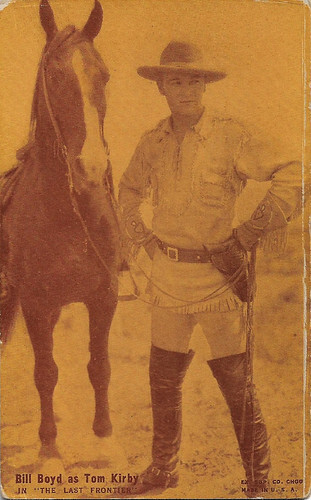
American Arcade card by Ex. Sup Co., Chicago. Photo: Metropolitan. William Boyd as Tom Kirby in The Last Frontier (Geoge B. Seitz, 1926).
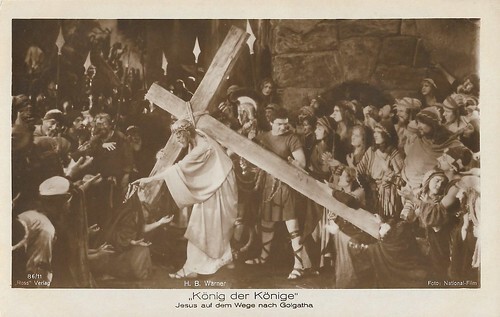
German postcard. Ross Verlag, no. 86/11. Photo: National Film. H.B. Warner in the American silent epic The King of Kings (Cecil B. DeMille, 1927). Caption: Jesus on the way to Golgotha. The man helping to carry the cross could be William Boyd, who played Simon of Cyrene.
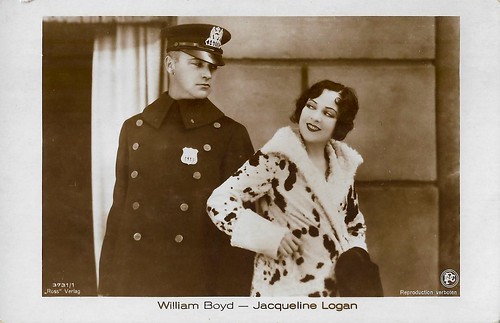
German postcard by Ross Verlag, no. 3731/1. Photo: DPG. Jacqueline Logan and William Boyd in The Cop (Donald Crisp, 1928).
A wholesome, chaste cowboy and a confirmed bachelor
At the beginning of the 1930s, William Boyd's career got a kink, as a newspaper article about the arrest of another actor, William "Stage" Boyd, on gambling and liquor charges were attributed to him. Despite the fact the culprit was just an actor with the same name, Boyd's contract with Radio Pictures was annulled and Boyd was virtually broke and without a job, and for years he had to survive.
His rescue came with the Western Hop-Along Cassidy (Howard Bretherton, 1935). It features the character Hop-Along Cassidy (named because of a limp caused by an earlier bullet wound) of pulp-writer Clarence E. Mulford's 'Bar 20' stories. Boyd was originally offered the role of Buck Peters, the ranch foreman, and Cassidy's old friend, but he decided to ask for the role of Hop-Along instead. Boyd regained his lost fame playing the prematurely gray, black-clad hero, with young Paramount contract player James Ellison as handsome sidekick Johnny Nelson and Charles Middleton as Buck Peters. Hopalong Cassidy's white horse was named 'Topper'.
The character Hopalong Cassidy accompanied him henceforth in his future career. 66 Hopalong Cassidy films were produced between 1935 and 1948, all starring William Boyd in the title role. The series was wildly popular, and all recouped at least double their production costs. Producer Harry Sherman left Paramount in 1942 in favour of United Artists where the "Hopalong" series continued to flourish until 1948. Boyd then bought the rights to the films and re-edited them for television. The 1949-1951 Hopalong Cassidy series was so popular that Boyd filmed 52 new half-hour episodes for the 1952-1954 seasons. Instead of the hard-drinking, rough character from the pulp magazines on which his character was based, Boyd's film character was a wholesome, chaste cowboy - a confirmed bachelor, quite unlike Boyd's own five marriages.
After 70 films, William Boyd recognised early on the possibilities of television and switched to the small screen, where from 1952 onwards he did fifty-two half-hour episodes after he had already shown from 1949 on NBC all of his 66 Hopalong Cassidy films. As he had bought the rights of these films (almost ruining him), he became a wealthy man. He marketed all sorts of "Hoppy" products (lunch boxes, toy guns, cowboy hats, etc.) and received royalties from comic books, radio, and records. In addition, he marketed the character in the circus, variety, and on promotional tours. In the November 27, 1950 issue, Boyd was put on Time magazine's front page and got a star on the Hollywood Walk of Fame.
He retired to Palm Desert, California, in 1953. In 1968 he had surgery to remove a tumor from a lymph gland and from then on refused all interview and photograph requests. In 1972, Boyd died from complications related to Parkinson's disease and congestive heart failure. He was 77. In 1995, he was immortalised in the Western Performers Hall of Fame at the National Cowboy & Western Heritage Museum in Oklahoma City. There is also a Hopalong Cassidy Museum in Cambridge, Ohio. Boyd was married five times, first to a wealthy heiress, Laura Maynard, then to the actresses Ruth Miller, Elinor Fair, Dorothy Sebastian, and Grace Bradley. His only child, a son by second wife Ruth Miller, died in infancy.
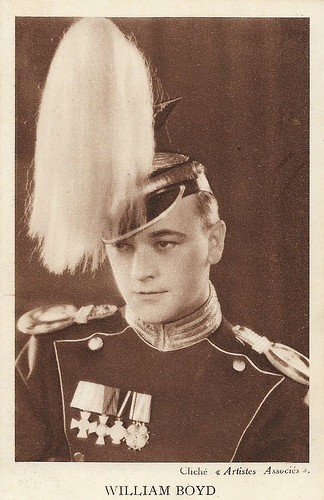
Belgian postcard. Photo Artistes Associés (United Artists). S.A. Cacao et Chocolat Kivou, Vilvoorde / N.V. Cacao en Chocolade Kivou, Vilvoorde. William Boyd in Lady of the Pavements (D.W. Griffith, 1929).
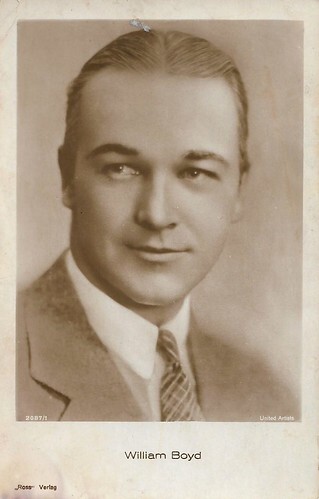
German postcard by Ross Verlag, no. 2087/1, 1927-1928. Photo: United Artists.
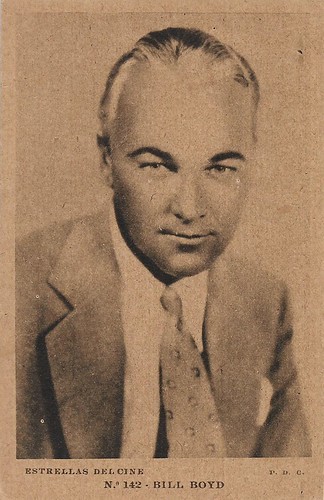
Spanish postcard in the Estrellas del cine by Editorial Grafica, Barcelona, no. 142. Photo: P.D.C. (Producers Distributing Corporation), a company that existed between 1924 and 1927.
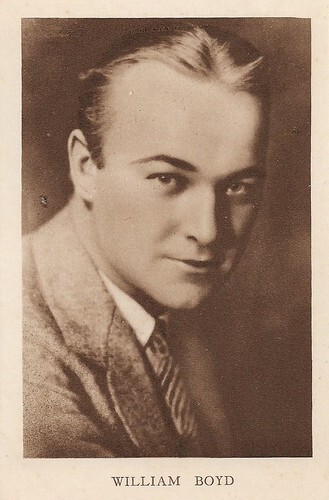
Belgian postcard by Ed. journal 'Cinema', Antwerp.
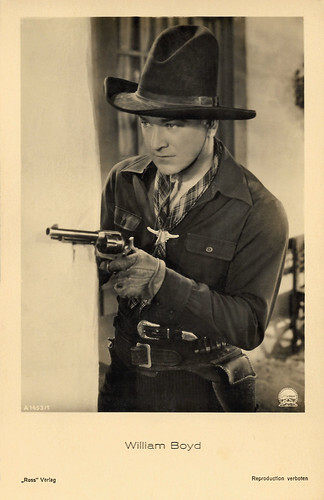
German postcard by Ross Verlag, no. A 1653/1, 1937-1938. Photo: Paramount.
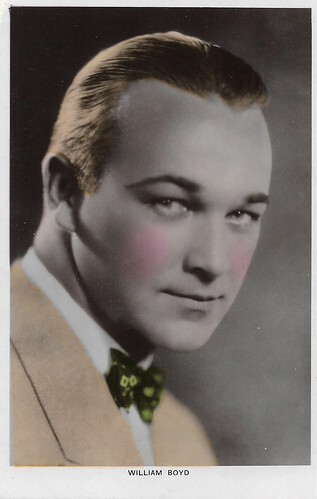
British postcard in the Colourgraph Series, London.
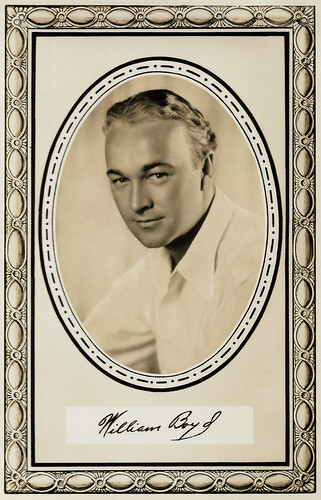
British postcard in the Autograph Series, London, no A 4.
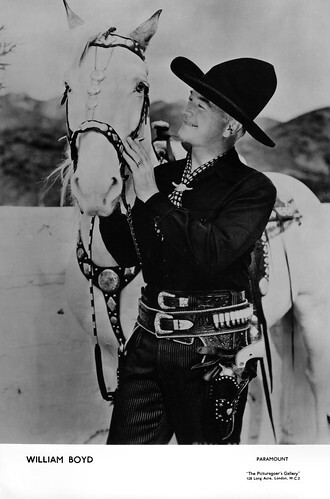
Big British card in the Picturegoer's Gallery, London. Photo: Paramount.
Sources: Hans J. Wollstein (AllMovie), (IMDb), Wikipedia (English and German), and .

German postcard by Ross Verlag, no. 4826/1,1929-1930. Photo: PDC. William Boyd in The Flying Fool (Tay Garnett, 1929).

French postcard by JRPR, Paris, no. 124. Photo: Erka Prodisco. Elinor Fair and William Boyd in The Volga Boatman (Cecil B. DeMille, 1926).

French postcard by Europe. no. 226. Photo: Erka Prodisco.

German postcard by Ross Verlag, no. 3934/1, 1928-1929. Photo: United Artists. William Boyd in Lady of the Pavements (D.W. Griffith, 1929).

British postcard in the Picturegoer Series, London, no. W.485. Photo: Exclusive Films. Caption: William Boyd & Topper.
Easy charm, charisma, and intense good-looks
William Boyd was born in 1895 in Hendrysburg, Ohio, and reared in Cambridge, Ohio, and lived in Tulsa from 1909 to 1913. He was the son of a day laborer, Charles William Boyd, and his wife, the former Lida Wilkens (aka Lyda). Following his father's death, he moved to California and worked as an orange picker, surveyor, tool dresser, and auto salesman.
During World War I, he enlisted in the army but was exempt from military service because of a "weak heart". In 1918, Boyd arrived in Hollywood and found work as an extra in Why Change Your Wife? (Cecil B. De Mille, 1920) and other films. He saved Cecil B. DeMille 's then-favorite actress Julia Faye an awkward situation during the shooting of Saturday Night (1922) when her bathing suit suddenly sprang open. Thanks to this, DeMille would give Boyd his chance a few years after.
Boyd had his definite breakthrough as Jack Moreland in The Road to Yesterday (Cecil B. DeMille, 1925), also with Joseph Schildkraut , Jetta Goudal , and Vera Reynolds. Critics praised Boyd's performance - as the virile minister Jack who doesn't mind kissing flapper Bess (Vera Reynolds) and knows to use his fists when necessary - while moviegoers loved his easy charm, charisma, and intense good-looks.
Due to his growing popularity, DeMille soon cast Boyd as the male lead in the highly successful silent drama, The Volga Boatman (1926). In Tsarist Russia, the Volga boatman Feodor (Boyd) meets Prince Dimitri ( Victor Varconi ) and his fiancée Vera (Elinor Fair). During the October Revolution, he meets Vera again when he has become a Red Army officer. He receives the order to shoot her but is impressed with her bravery and saves her. Both flee but then have to face the power of Dimitri.
After this film, Boyd had definitely become a matinee idol. He began earning an annual salary of $100,000. He acted in DeMille's extravaganza The King of Kings (Cecil B. DeMille, 1927) in which he played Simon of Cyrene, helping Jesus carry the cross, and DeMille's Skyscraper (Cecil B. DeMille, 1928). He then appeared in D.W. Griffith 's Lady of the Pavements (1929) opposite Lupe Velez and Jetta Goudal . Griffith reshot the film to include a couple of musical numbers, making it a part-talkie.

French postcard by JRPR, Paris, no. 123. Photo: Erka Prodisco. William Boyd in The Volga Boatman (Cecil B. DeMille, 1926). This image is a pictorial citation of the famous painting 'Volga Boatmen/ Barge Haulers on the Volga' (1870-1873) by Ilia Efimovich Repin (1844-1930).

German postcard by Ross Verlag, no. 1721/1, 1927-1928. Photo: Arthur Ziehm, Berlin. William Boyd as Tom Kirby in The Last Frontier (Geoge B. Seitz, 1926).

American Arcade card by Ex. Sup Co., Chicago. Photo: Metropolitan. William Boyd as Tom Kirby in The Last Frontier (Geoge B. Seitz, 1926).

German postcard. Ross Verlag, no. 86/11. Photo: National Film. H.B. Warner in the American silent epic The King of Kings (Cecil B. DeMille, 1927). Caption: Jesus on the way to Golgotha. The man helping to carry the cross could be William Boyd, who played Simon of Cyrene.

German postcard by Ross Verlag, no. 3731/1. Photo: DPG. Jacqueline Logan and William Boyd in The Cop (Donald Crisp, 1928).
A wholesome, chaste cowboy and a confirmed bachelor
At the beginning of the 1930s, William Boyd's career got a kink, as a newspaper article about the arrest of another actor, William "Stage" Boyd, on gambling and liquor charges were attributed to him. Despite the fact the culprit was just an actor with the same name, Boyd's contract with Radio Pictures was annulled and Boyd was virtually broke and without a job, and for years he had to survive.
His rescue came with the Western Hop-Along Cassidy (Howard Bretherton, 1935). It features the character Hop-Along Cassidy (named because of a limp caused by an earlier bullet wound) of pulp-writer Clarence E. Mulford's 'Bar 20' stories. Boyd was originally offered the role of Buck Peters, the ranch foreman, and Cassidy's old friend, but he decided to ask for the role of Hop-Along instead. Boyd regained his lost fame playing the prematurely gray, black-clad hero, with young Paramount contract player James Ellison as handsome sidekick Johnny Nelson and Charles Middleton as Buck Peters. Hopalong Cassidy's white horse was named 'Topper'.
The character Hopalong Cassidy accompanied him henceforth in his future career. 66 Hopalong Cassidy films were produced between 1935 and 1948, all starring William Boyd in the title role. The series was wildly popular, and all recouped at least double their production costs. Producer Harry Sherman left Paramount in 1942 in favour of United Artists where the "Hopalong" series continued to flourish until 1948. Boyd then bought the rights to the films and re-edited them for television. The 1949-1951 Hopalong Cassidy series was so popular that Boyd filmed 52 new half-hour episodes for the 1952-1954 seasons. Instead of the hard-drinking, rough character from the pulp magazines on which his character was based, Boyd's film character was a wholesome, chaste cowboy - a confirmed bachelor, quite unlike Boyd's own five marriages.
After 70 films, William Boyd recognised early on the possibilities of television and switched to the small screen, where from 1952 onwards he did fifty-two half-hour episodes after he had already shown from 1949 on NBC all of his 66 Hopalong Cassidy films. As he had bought the rights of these films (almost ruining him), he became a wealthy man. He marketed all sorts of "Hoppy" products (lunch boxes, toy guns, cowboy hats, etc.) and received royalties from comic books, radio, and records. In addition, he marketed the character in the circus, variety, and on promotional tours. In the November 27, 1950 issue, Boyd was put on Time magazine's front page and got a star on the Hollywood Walk of Fame.
He retired to Palm Desert, California, in 1953. In 1968 he had surgery to remove a tumor from a lymph gland and from then on refused all interview and photograph requests. In 1972, Boyd died from complications related to Parkinson's disease and congestive heart failure. He was 77. In 1995, he was immortalised in the Western Performers Hall of Fame at the National Cowboy & Western Heritage Museum in Oklahoma City. There is also a Hopalong Cassidy Museum in Cambridge, Ohio. Boyd was married five times, first to a wealthy heiress, Laura Maynard, then to the actresses Ruth Miller, Elinor Fair, Dorothy Sebastian, and Grace Bradley. His only child, a son by second wife Ruth Miller, died in infancy.

Belgian postcard. Photo Artistes Associés (United Artists). S.A. Cacao et Chocolat Kivou, Vilvoorde / N.V. Cacao en Chocolade Kivou, Vilvoorde. William Boyd in Lady of the Pavements (D.W. Griffith, 1929).

German postcard by Ross Verlag, no. 2087/1, 1927-1928. Photo: United Artists.

Spanish postcard in the Estrellas del cine by Editorial Grafica, Barcelona, no. 142. Photo: P.D.C. (Producers Distributing Corporation), a company that existed between 1924 and 1927.

Belgian postcard by Ed. journal 'Cinema', Antwerp.

German postcard by Ross Verlag, no. A 1653/1, 1937-1938. Photo: Paramount.

British postcard in the Colourgraph Series, London.

British postcard in the Autograph Series, London, no A 4.

Big British card in the Picturegoer's Gallery, London. Photo: Paramount.
Sources: Hans J. Wollstein (AllMovie), (IMDb), Wikipedia (English and German), and .
Published on October 20, 2021 22:00
October 19, 2021
Kill Bill (2003-2004)
The two-part American martial arts film Kill Bill: Volume 1 (Quentin Tarantino, 2003-2004) stars Uma Thurman as the Bride (code name Black Mamba), a former member of a team of assassins, the Deadly Viper Assassination Squad, described as "the deadliest woman in the world". She swears revenge on the Deadly Viper Assassination Squad (Lucy Liu, Michael Madsen, Daryl Hannah, and Vivica A. Fox) and their leader, Bill (David Carradine), after they try to kill her and her unborn child. Her journey takes her to Tokyo, where she battles the yakuza.
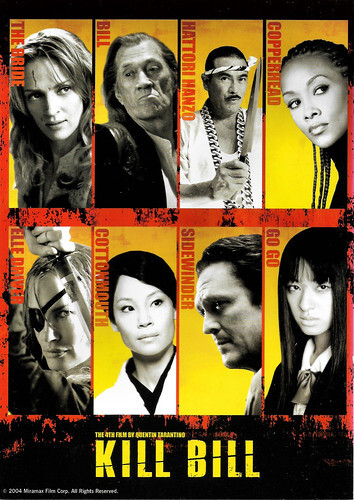
British postcard by Pyramid Posters, Leicester, no. PC9458, 2004. Photo: Miramax / A Band Apart. The main cast members in Kill Bill (Quentin Tarantino, 2003-2004). Caption: The 4th film of Quentin Tarantino.
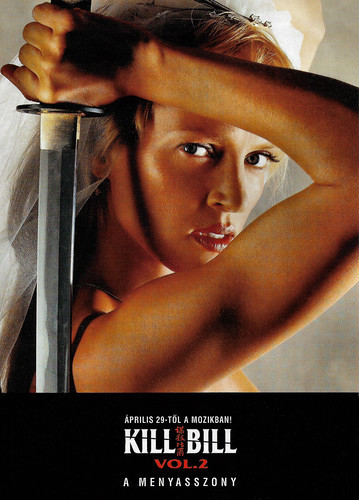
Hungarian postcard by Est Media, Budapest. Uma Thurman as The Bride in Kill Bill, Vol. 2 (Quentin Tarantino, 2004). Caption: Aprilis 29 - Töl a Mozikban. (In the cinema from 29 April).
A 1970s style kung-fu flick
Writer-director Quentin Tarantino and actress Uma Thurman conceived the Bride character during the production of Tarantino's Pulp Fiction (1994); Kill Bill credits the story to "Q & U". The two began talking about the kinds of films that they would like to do, and Quentin said he would like to do a 1970s style kung-fu flick. Uma came up with the film's opening shot of her beaten up and wearing a wedding gown.
Tarantino spent a year and a half writing the script while he was living in New York City in 2000 and 2001, spending time with Thurman and her newborn daughter Maya. Reuniting with the more mature Thurman, now a mother, influenced the way Tarantino wrote the Bride character; he did not come to the realization that the Bride's child could still be alive until the end of the writing process.
He originally wrote Bill for Warren Beatty, but as the character developed and the role required greater screen time and martial arts training, he rewrote it for David Carradine.
Tarantino decided to cast Daryl Hannah as Elle Driver after seeing her performance as a secret agent in the television film First Target (Armand Mastroianni, 2000). The physical similarities between Thurman and Hannah inspired how he wrote the rivalry between the two characters.
Tarantino conceived Kill Bill as a homage to grindhouse cinema, including Martial Arts films, samurai cinema, Blaxploitation, and Spaghetti Westerns. It features an anime sequence by Production I.G.
Tarantino revealed in an interview that the music used in Kill Bill was all from other films. He used music from his soundtrack collection. It is the first of two Kill Bill films made in a single production. They were planned as a single release, but the film, with a runtime of over four hours, was divided into two. Volume 2 was released the following year. Volume 1 grossed over $180 million on a $30 million budget.
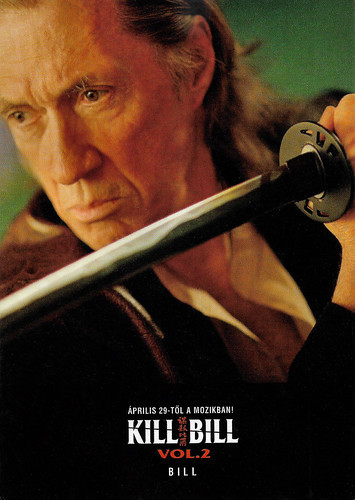
Hungarian postcard by Est Media, Budapest. David Carradine as Bill in Kill Bill, Vol. 2 (Quentin Tarantino, 2004). Caption: Aprilis 29 - Töl a Mozikban. (In the cinema from 29 April).
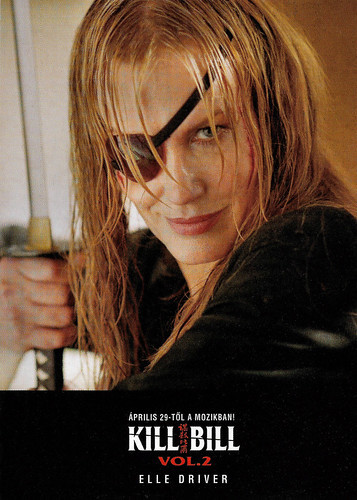
Hungarian postcard by Est Media, Budapest. Daryl Hannah as Elle Driver in Kill Bill, Vol. 2 (Quentin Tarantino, 2004). Caption: Aprilis 29 - Töl a Mozikban. (In the cinema from 29 April).
Attacked by the Deadly Viper Assassination Squad
A woman in a wedding dress, the Bride ( Uma Thurman ), lies wounded in a chapel in El Paso, Texas, having been attacked by the Deadly Viper Assassination Squad. She tells their leader, Bill (David Carradine), that she is pregnant with his baby just before he shoots her in the head.
Four years later, the Bride awakens from her coma and is horrified to find that she is no longer pregnant. She kills a man who tries to rape her and a hospital worker who has been selling her body while she was comatose. She takes the hospital worker's truck and teaches herself to walk again.
The Bride goes to the home of Vernita Green (Vivica A. Fox), planning to kill her. Both women were members of the Deadly Vipers, which has since disbanded; Vernita now leads a normal suburban family life. They engage in a knife fight but are interrupted by the arrival of Vernita's young daughter, Nikki. The Bride agrees to meet Vernita at night to settle the matter, but when Vernita tries to shoot the Bride with a pistol hidden in a box of cereal, the Bride throws a knife into Vernita's chest, killing her. Nikki witnesses the killing, and the Bride offers her a chance to avenge her mother's death when she grows up, should she choose to do so.
Four years earlier, police investigate the massacre at the wedding chapel. The sheriff discovers that the Bride is alive but comatose. In the hospital, Deadly Viper Elle Driver (Daryl Hannah) prepares to assassinate the Bride via lethal injection, but Bill aborts the mission at the last moment, considering it dishonorable to kill the Bride when she cannot defend herself.
Resolving to kill Bill and the other Deadly Vipers, the Bride picks her first target: O-Ren Ishii (Lucy Liu), now the leader of the Tokyo yakuza. O-Ren's parents were murdered by the yakuza when she was a child; she took vengeance on the yakuza boss and replaced him after training as an elite assassin. The Bride travels to Okinawa, Japan, to obtain a sword from legendary swordsmith Hattori Hanzō (Sonny Chiba), who has sworn never to forge a sword again.
After learning that her target is Bill, his former student, he relents and crafts his finest sword for her, taking a month to finish the job. The Bride tracks O-Ren to the House of Blue Leaves, a Tokyo restaurant, and amputates the arm of her assistant, Sofie Fatale (Julie Dreyfus). She defeats the Crazy 88, O-Ren's squad of elite fighters, and kills her bodyguard, schoolgirl Gogo Yubari (Chiaki Kuriyama). O-Ren and the Bride duel in the restaurant's Japanese garden; the Bride gains the upper hand and kills O-Ren by slicing off the top of her head. After torturing Sofie for information about Bill, the Bride leaves her alive as a threat. Bill finds Sofie and asks her if the Bride knows that her daughter is alive.
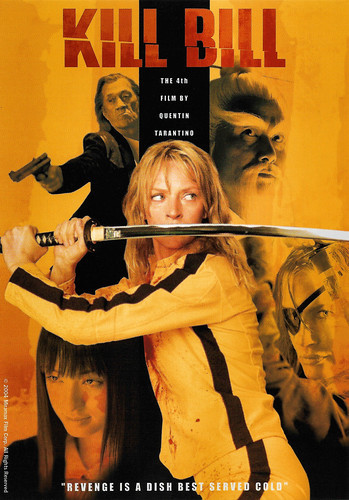
British postcard by Pyramid Posters, Leicester, no. PC 9471. Photo: Miramax Films / A Band Apart. Uma Thurman (montage) in Kill Bill (Quentin Tarantino, 2003). Caption: The 4th film by Quentin Tarantino. "Revenge is a dish best served cold".
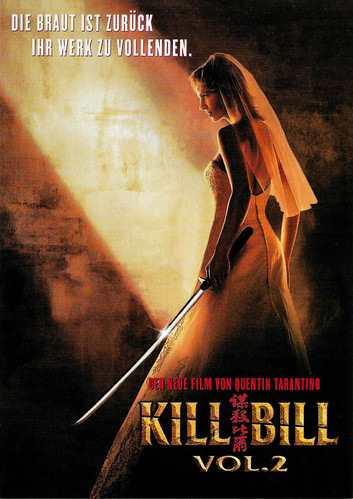
German postcard by Edgar Medien. Photo: Buena Vista International. Uma Thurman in Kill Bill: Vol. 2 (Quentin Tarantino, 2004). Caption: The bride is back to finish her work.
Revenge is a dish best served cold
In Kill Bill, Vol 2 (Quentin Tarantino, 2004), the Bride (Uma Thurman) continues her quest for vengeance against her former boss and lover Bill (David Carradine). Having dispatched several of her arch-enemies in the first film, she now pursuits the reclusive bouncer and Bill's younger beer-swilling brother Budd (Michael Madsen), and the treacherous, one-eyed Elle Driver (Daryl Hannah).
Bill, Bud, and Elle are the only survivors from the squad of assassins who attempted to murder her and her unborn child on her wedding day in a furious assault. It's all leading up to the ultimate confrontation with Bill, the Bride's former master, and the man who ordered her execution! Like Volume 1, Volume 2 received positive reviews and was a box-office hit.
Kill Bill Vol. 2 stands on its own, although Vol. 1 and Vol. 2 were planned and produced as a single film. After editing began, producer Harvey Weinstein, who was known for pressuring filmmakers to shorten their films, suggested that Tarantino split the film in two. The decision was announced in July 2003. Vol. 2 is not a sequel but a continuation and completion. It is a distillation of the countless grindhouse Kung-fu movies Tarantino has absorbed and transcends.
Perry Seibert at AllMovie : "Where Volume 1 offered the most visually freewheeling Tarantino work ever, Volume 2 showcases how deliberate his intentions are. Take the training sequence with Pai Mei: This looks like every kung fu movie that ever played on a Saturday afternoon on your local UHF station. The cheesy zooms, the arch dialogue, and the faux-mystical bearded mentor are all intricately planned and in place. These elements are not kitsch; Tarantino genuinely loves these genre tropes and wants nothing more than to share that love with the audience while never taking his eye off the story. This is exactly what he accomplishes in Kill Bill, and he does it with confidence."
Vol. 2 opens with a long closeup of The Bride behind the wheel of a car, explaining her mission, which is to kill Bill. Flashbacks remind us that the pregnant Bride and her entire wedding party were targeted by the Deadly Viper Assassination Squad in a massacre at the Two Pines Wedding Chapel. Bill was responsible. Roger Ebert at RogerEbert.com : "He's played by David Carradine in a performance that somehow, improbably, suggests that Bill and the Bride had a real relationship despite the preposterous details surrounding it. (Bill is deeply offended that she plans to marry a used record store owner and lead a normal life.)"
In "Volume 2," The Bride meets the warrior master Pai Mei (Gordon Liu), who lives on the top of a high, lonely hill reached by climbing many stairs. He was Bill's master, and in a flashback, Bill delivers his protege for training. Pai Mei is a harsh and uncompromising teacher, and the Bride sheds blood during their unrelenting sessions. The training with Pai Mei prepared The Bride to begin her career with Bill. In the action that takes place "now," The Bride has to fight her way past formidable opponents, including Elle Driver (Daryl Hannah), the one-eyed master of martial arts, and Budd (Michael Madsen), who works as a bouncer in a strip joint and lives in a mobile home surrounded by desolation.
Neither one is a pushover for The Bride. The showdown with Budd involves a sequence where it seems The Bride must surely die after being buried alive. The fight with Elle Driver is a virtuoso celebration of fight choreography. Their battle takes place inside Budd's trailer home, which is pretty much demolished in the process. Roger Ebert: " Tarantino, who began the film in black and white before switching to color, plays with formats here, too; to suggest the claustrophobia of being buried, he shows The Bride inside her wooden casket, and as clods of earth rain down on the lid, he switches from widescreen to the classic 4x3 screen ratio."
As with Tarantino's previous films, Kill Bill features an eclectic soundtrack comprising many musical genres. On the two soundtracks, the music ranges from country music to selections from the Spaghetti Western film scores of Ennio Morricone. Bernard Herrmann's theme from the film Twisted Nerve is whistled by the menacing Elle Driver in the hospital scene. A brief, 15-second excerpt from the opening of the Ironside theme music by Quincy Jones is used as the Bride's revenge motif, which flares up with a red-tinged flashback whenever she is in the company of her next target.
Roger Ebert: "One of the achievements of "Volume 2" is that the story is filled in, the characters are developed, and they do begin to resonate, especially during the extraordinary final meeting between The Bride and Bill - which consists not of nonstop action but of more hypnotic dialogue and ends in an event that is like a quiet, deadly punch line. Put the two parts together, and Tarantino has made a masterful saga that celebrates the martial arts genre while kidding it, loving it, and transcending it. I confess I feared that "Volume 2" would be like those sequels that lack the intensity of the original. But this is all one film, and now that we see it whole, it's greater than its two parts; Tarantino remains the most brilliantly oddball filmmaker of his generation, and this is one of the best films of the year."
Kill Bill Vol. 2 grossed $25.1 million on its opening weekend, which was higher than Vol. 1's, and the equivalent success confirmed the studio's financial decision to split the film into two theatrical releases. Vol. 2 grossed a total of $66.2 million in the United States and Canada and $86 million in other territories for a worldwide total of $152.2 million. In June 2021, Quentin Tarantino stated that a potential Kill Bill Vol. 3 would take place 20 years following the original volumes and that he was excited about the possibility of Uma Thurman and her daughter Maya Hawke playing the Bride and her daughter B.B. respectively.
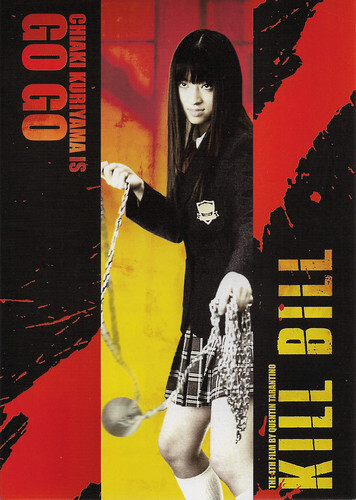
British postcard by Pyramid Posters, Leicester, no. PC9462. Photo: Miramax / A Band Apart. Chiaki Kuriyama as Gogo Yubari in Kill Bill (Quentin Tarantino, 2003). Caption: The 4th film by Quentin Tarantino. When Kuriyama was shooting this scene where she flings her ball and chain out, she accidentally hit Quentin Tarantino on the head as he stood by the camera.
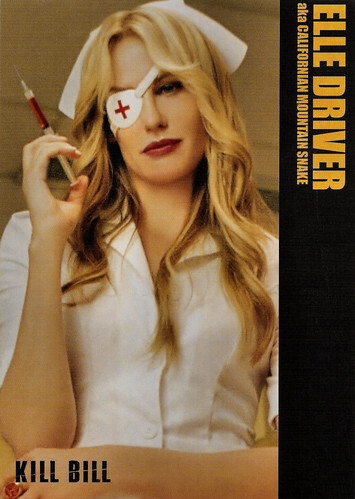
British postcard by Pyramid Posters, Leicester, no. PC9465. Photo: Miramax / A Band Apart. Daryl Hannah as Elle Driver in Kill Bill (Quentin Tarantino, 2003). Caption: Elle Driver a.k.a. Californian Mountain Snake.
Sources: Sources: Roger Ebert (RogerEbert.com), Perry Seibert (AllMovie), Wikipedia, and IMDb.

British postcard by Pyramid Posters, Leicester, no. PC9458, 2004. Photo: Miramax / A Band Apart. The main cast members in Kill Bill (Quentin Tarantino, 2003-2004). Caption: The 4th film of Quentin Tarantino.

Hungarian postcard by Est Media, Budapest. Uma Thurman as The Bride in Kill Bill, Vol. 2 (Quentin Tarantino, 2004). Caption: Aprilis 29 - Töl a Mozikban. (In the cinema from 29 April).
A 1970s style kung-fu flick
Writer-director Quentin Tarantino and actress Uma Thurman conceived the Bride character during the production of Tarantino's Pulp Fiction (1994); Kill Bill credits the story to "Q & U". The two began talking about the kinds of films that they would like to do, and Quentin said he would like to do a 1970s style kung-fu flick. Uma came up with the film's opening shot of her beaten up and wearing a wedding gown.
Tarantino spent a year and a half writing the script while he was living in New York City in 2000 and 2001, spending time with Thurman and her newborn daughter Maya. Reuniting with the more mature Thurman, now a mother, influenced the way Tarantino wrote the Bride character; he did not come to the realization that the Bride's child could still be alive until the end of the writing process.
He originally wrote Bill for Warren Beatty, but as the character developed and the role required greater screen time and martial arts training, he rewrote it for David Carradine.
Tarantino decided to cast Daryl Hannah as Elle Driver after seeing her performance as a secret agent in the television film First Target (Armand Mastroianni, 2000). The physical similarities between Thurman and Hannah inspired how he wrote the rivalry between the two characters.
Tarantino conceived Kill Bill as a homage to grindhouse cinema, including Martial Arts films, samurai cinema, Blaxploitation, and Spaghetti Westerns. It features an anime sequence by Production I.G.
Tarantino revealed in an interview that the music used in Kill Bill was all from other films. He used music from his soundtrack collection. It is the first of two Kill Bill films made in a single production. They were planned as a single release, but the film, with a runtime of over four hours, was divided into two. Volume 2 was released the following year. Volume 1 grossed over $180 million on a $30 million budget.

Hungarian postcard by Est Media, Budapest. David Carradine as Bill in Kill Bill, Vol. 2 (Quentin Tarantino, 2004). Caption: Aprilis 29 - Töl a Mozikban. (In the cinema from 29 April).

Hungarian postcard by Est Media, Budapest. Daryl Hannah as Elle Driver in Kill Bill, Vol. 2 (Quentin Tarantino, 2004). Caption: Aprilis 29 - Töl a Mozikban. (In the cinema from 29 April).
Attacked by the Deadly Viper Assassination Squad
A woman in a wedding dress, the Bride ( Uma Thurman ), lies wounded in a chapel in El Paso, Texas, having been attacked by the Deadly Viper Assassination Squad. She tells their leader, Bill (David Carradine), that she is pregnant with his baby just before he shoots her in the head.
Four years later, the Bride awakens from her coma and is horrified to find that she is no longer pregnant. She kills a man who tries to rape her and a hospital worker who has been selling her body while she was comatose. She takes the hospital worker's truck and teaches herself to walk again.
The Bride goes to the home of Vernita Green (Vivica A. Fox), planning to kill her. Both women were members of the Deadly Vipers, which has since disbanded; Vernita now leads a normal suburban family life. They engage in a knife fight but are interrupted by the arrival of Vernita's young daughter, Nikki. The Bride agrees to meet Vernita at night to settle the matter, but when Vernita tries to shoot the Bride with a pistol hidden in a box of cereal, the Bride throws a knife into Vernita's chest, killing her. Nikki witnesses the killing, and the Bride offers her a chance to avenge her mother's death when she grows up, should she choose to do so.
Four years earlier, police investigate the massacre at the wedding chapel. The sheriff discovers that the Bride is alive but comatose. In the hospital, Deadly Viper Elle Driver (Daryl Hannah) prepares to assassinate the Bride via lethal injection, but Bill aborts the mission at the last moment, considering it dishonorable to kill the Bride when she cannot defend herself.
Resolving to kill Bill and the other Deadly Vipers, the Bride picks her first target: O-Ren Ishii (Lucy Liu), now the leader of the Tokyo yakuza. O-Ren's parents were murdered by the yakuza when she was a child; she took vengeance on the yakuza boss and replaced him after training as an elite assassin. The Bride travels to Okinawa, Japan, to obtain a sword from legendary swordsmith Hattori Hanzō (Sonny Chiba), who has sworn never to forge a sword again.
After learning that her target is Bill, his former student, he relents and crafts his finest sword for her, taking a month to finish the job. The Bride tracks O-Ren to the House of Blue Leaves, a Tokyo restaurant, and amputates the arm of her assistant, Sofie Fatale (Julie Dreyfus). She defeats the Crazy 88, O-Ren's squad of elite fighters, and kills her bodyguard, schoolgirl Gogo Yubari (Chiaki Kuriyama). O-Ren and the Bride duel in the restaurant's Japanese garden; the Bride gains the upper hand and kills O-Ren by slicing off the top of her head. After torturing Sofie for information about Bill, the Bride leaves her alive as a threat. Bill finds Sofie and asks her if the Bride knows that her daughter is alive.

British postcard by Pyramid Posters, Leicester, no. PC 9471. Photo: Miramax Films / A Band Apart. Uma Thurman (montage) in Kill Bill (Quentin Tarantino, 2003). Caption: The 4th film by Quentin Tarantino. "Revenge is a dish best served cold".

German postcard by Edgar Medien. Photo: Buena Vista International. Uma Thurman in Kill Bill: Vol. 2 (Quentin Tarantino, 2004). Caption: The bride is back to finish her work.
Revenge is a dish best served cold
In Kill Bill, Vol 2 (Quentin Tarantino, 2004), the Bride (Uma Thurman) continues her quest for vengeance against her former boss and lover Bill (David Carradine). Having dispatched several of her arch-enemies in the first film, she now pursuits the reclusive bouncer and Bill's younger beer-swilling brother Budd (Michael Madsen), and the treacherous, one-eyed Elle Driver (Daryl Hannah).
Bill, Bud, and Elle are the only survivors from the squad of assassins who attempted to murder her and her unborn child on her wedding day in a furious assault. It's all leading up to the ultimate confrontation with Bill, the Bride's former master, and the man who ordered her execution! Like Volume 1, Volume 2 received positive reviews and was a box-office hit.
Kill Bill Vol. 2 stands on its own, although Vol. 1 and Vol. 2 were planned and produced as a single film. After editing began, producer Harvey Weinstein, who was known for pressuring filmmakers to shorten their films, suggested that Tarantino split the film in two. The decision was announced in July 2003. Vol. 2 is not a sequel but a continuation and completion. It is a distillation of the countless grindhouse Kung-fu movies Tarantino has absorbed and transcends.
Perry Seibert at AllMovie : "Where Volume 1 offered the most visually freewheeling Tarantino work ever, Volume 2 showcases how deliberate his intentions are. Take the training sequence with Pai Mei: This looks like every kung fu movie that ever played on a Saturday afternoon on your local UHF station. The cheesy zooms, the arch dialogue, and the faux-mystical bearded mentor are all intricately planned and in place. These elements are not kitsch; Tarantino genuinely loves these genre tropes and wants nothing more than to share that love with the audience while never taking his eye off the story. This is exactly what he accomplishes in Kill Bill, and he does it with confidence."
Vol. 2 opens with a long closeup of The Bride behind the wheel of a car, explaining her mission, which is to kill Bill. Flashbacks remind us that the pregnant Bride and her entire wedding party were targeted by the Deadly Viper Assassination Squad in a massacre at the Two Pines Wedding Chapel. Bill was responsible. Roger Ebert at RogerEbert.com : "He's played by David Carradine in a performance that somehow, improbably, suggests that Bill and the Bride had a real relationship despite the preposterous details surrounding it. (Bill is deeply offended that she plans to marry a used record store owner and lead a normal life.)"
In "Volume 2," The Bride meets the warrior master Pai Mei (Gordon Liu), who lives on the top of a high, lonely hill reached by climbing many stairs. He was Bill's master, and in a flashback, Bill delivers his protege for training. Pai Mei is a harsh and uncompromising teacher, and the Bride sheds blood during their unrelenting sessions. The training with Pai Mei prepared The Bride to begin her career with Bill. In the action that takes place "now," The Bride has to fight her way past formidable opponents, including Elle Driver (Daryl Hannah), the one-eyed master of martial arts, and Budd (Michael Madsen), who works as a bouncer in a strip joint and lives in a mobile home surrounded by desolation.
Neither one is a pushover for The Bride. The showdown with Budd involves a sequence where it seems The Bride must surely die after being buried alive. The fight with Elle Driver is a virtuoso celebration of fight choreography. Their battle takes place inside Budd's trailer home, which is pretty much demolished in the process. Roger Ebert: " Tarantino, who began the film in black and white before switching to color, plays with formats here, too; to suggest the claustrophobia of being buried, he shows The Bride inside her wooden casket, and as clods of earth rain down on the lid, he switches from widescreen to the classic 4x3 screen ratio."
As with Tarantino's previous films, Kill Bill features an eclectic soundtrack comprising many musical genres. On the two soundtracks, the music ranges from country music to selections from the Spaghetti Western film scores of Ennio Morricone. Bernard Herrmann's theme from the film Twisted Nerve is whistled by the menacing Elle Driver in the hospital scene. A brief, 15-second excerpt from the opening of the Ironside theme music by Quincy Jones is used as the Bride's revenge motif, which flares up with a red-tinged flashback whenever she is in the company of her next target.
Roger Ebert: "One of the achievements of "Volume 2" is that the story is filled in, the characters are developed, and they do begin to resonate, especially during the extraordinary final meeting between The Bride and Bill - which consists not of nonstop action but of more hypnotic dialogue and ends in an event that is like a quiet, deadly punch line. Put the two parts together, and Tarantino has made a masterful saga that celebrates the martial arts genre while kidding it, loving it, and transcending it. I confess I feared that "Volume 2" would be like those sequels that lack the intensity of the original. But this is all one film, and now that we see it whole, it's greater than its two parts; Tarantino remains the most brilliantly oddball filmmaker of his generation, and this is one of the best films of the year."
Kill Bill Vol. 2 grossed $25.1 million on its opening weekend, which was higher than Vol. 1's, and the equivalent success confirmed the studio's financial decision to split the film into two theatrical releases. Vol. 2 grossed a total of $66.2 million in the United States and Canada and $86 million in other territories for a worldwide total of $152.2 million. In June 2021, Quentin Tarantino stated that a potential Kill Bill Vol. 3 would take place 20 years following the original volumes and that he was excited about the possibility of Uma Thurman and her daughter Maya Hawke playing the Bride and her daughter B.B. respectively.

British postcard by Pyramid Posters, Leicester, no. PC9462. Photo: Miramax / A Band Apart. Chiaki Kuriyama as Gogo Yubari in Kill Bill (Quentin Tarantino, 2003). Caption: The 4th film by Quentin Tarantino. When Kuriyama was shooting this scene where she flings her ball and chain out, she accidentally hit Quentin Tarantino on the head as he stood by the camera.

British postcard by Pyramid Posters, Leicester, no. PC9465. Photo: Miramax / A Band Apart. Daryl Hannah as Elle Driver in Kill Bill (Quentin Tarantino, 2003). Caption: Elle Driver a.k.a. Californian Mountain Snake.
Sources: Sources: Roger Ebert (RogerEbert.com), Perry Seibert (AllMovie), Wikipedia, and IMDb.
Published on October 19, 2021 22:00
October 18, 2021
Annekathrin Bürger
Annekathrin Bürger (1937) is a German stage, film, and television actress. Bürger was a prominent actress in East Germany appearing in a number of films made by the state-run DEFA film studios as well as in television series such as Wolf Among Wolves (1965) set in 1920s Berlin. In 1972 she played the female lead in the Ostern Tecumseh (1972).

East-German postcard by VEB Progress Film-Vertrieb, Berlin, no. 1901, 1963. Photo: Ludwig Schirmer.

East-German postcard by VEB Progress Film-Vertrieb, Berlin, no. 2569, 1966. Photo: Arno Fischer.

East-German postcard by VEB Progress Film-Vertrieb, Berlin, no. 3239, 1968. Photo: DEFA / Dietrich.

East-German postcard by VEB Progress Film-Vertrieb, Berlin, no. 9/72. Photo: Schütz. Annekathrin Bürger in Tecumseh (Hans Kratzert, 1972).
Unprecedentedly libertine in regards to sexuality
Annekathrin Bürger was born Annekathrin Rammelt in 1937 in Berlin-Charlottenburg, Nazi Germany. Her father was the animal draftsman and illustrator Heinz Rammelt.
She grew up in Hornhausen, trained as an advertising designer in Bernburg, and worked as a stage design assistant, prop master, and extra at the Carl-Maria-von-Weber-Theater there. She failed the entrance exam for the State Drama School in Berlin.
In the summer of 1955, she met Czech film people in Berlin and played her first small role as a pioneer leader in the Czech-German short film Gebirge und Meer/Mountains and sea (Wolfgang Bartsch, Bohumil Vosahlik, 1955).
A year later she appeared in the East German neo-realist romantic drama Eine Berliner Romanze/A Berlin Romance (Gerhard Klein, 1956), a film about youth urban life in the divided city of Berlin. It was produced by the DEFA, the state-owned East German studio. Annekathrin Bürger's co-stars were Ulrich Thein and Uwe-Jens Pape. It is still amongst DEFA's best-known films.
Bürger studied acting at the Potsdam Film and Television Academy from 1957 to 1960. From 1959 to 1960 she was engaged at the Deutsches Theater in Berlin. She also starred in another youth film, Reportage 57 (János Veiczi, 1959), and the romantic comedy Verwirrung der Liebe/Love's Confusion (Slátan Dudow, 1959), both with Willi Schrade. Love's Confusion was Dudow's last film and the screen debut of Angelica Domröse . Influenced by the relaxed political climate ushered with the Khrushchev Thaw, the picture was unprecedentedly libertine in regards to sexuality. It became a huge hit.
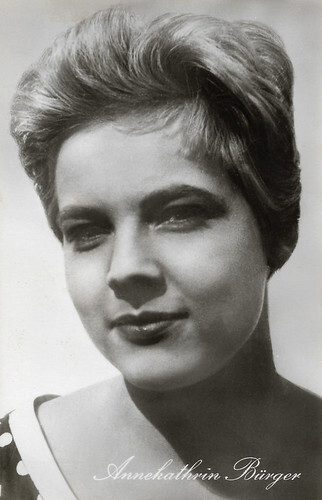
East-German postcard by VEB Progress Film-Vertrieb, Berlin, no. 639, 1958. Photo: Gerhard Puhlmann.
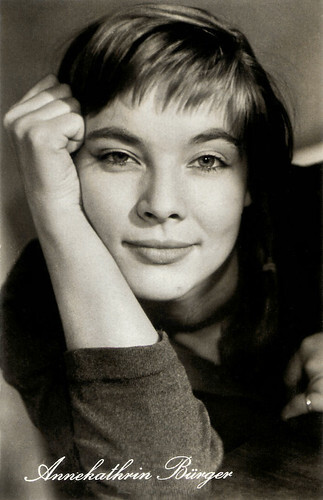
East-German postcard by VEB Progress Film-Vertrieb, Berlin, no. 710, 1958. Photo: Günther Ost.
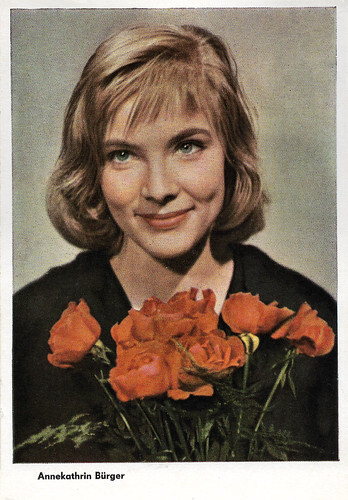
East-German postcard by VEB Progress Film-Vertrieb, Berlin, no. 1.327 F, 1960. Photo: DEFA - Neufeld.
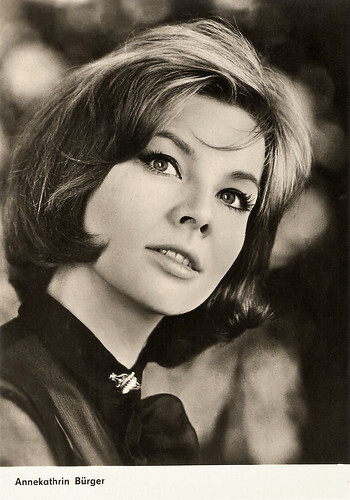
East-German postcard by VEB Progress Film-Vertrieb, Berlin, no. 2087, 1964. Photo: Ludwig Schirmer.
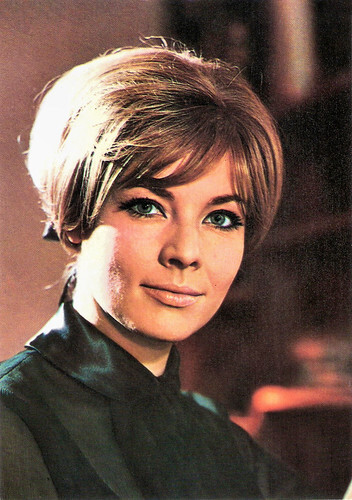
East-German postcard by VEB Progress Film-Vertrieb, Berlin, no. 2.253, 1965. Photo: DEFA / Schirmer.
The only DEFA film looking at Nazi Germany history in East Germany
During the early 1960s, Annekathrin Bürger appeared in a series of DEFA productions, such as Septemberliebe/September Love (Kurt Maetzig, 1961) with Doris Abesser and Ulrich Thein .
She also starred in the first joint Soviet–East German film, Pyat Dney, Pyat Nochei/Fünf Tage, Fünf Nächte/Five Days, Five Nights (Lev Arnshtam, Heinz Thiel, 1961) with Wilhelm Koch-Hooge.
The picture's plot was inspired by the recovery of the art of the Old Masters Picture Gallery through the hands of Soviet troops in 1945. The art collection was then taken to the USSR, where it was kept until being returned to the Dresden Gallery in 1960. Five Days, Five Nights sold more than two million tickets in the German Democratic Republic.
Then she starred in the romantic war drama Königskinder/Star-Crossed Lovers (Frank Beyer, 1962) with Armin Mueller-Stahl , and in the drama Das zweite Gleis/The Second Track (Joachim Kunert, 1962), as the daughter of Albert Hetterle. It is the only DEFA film looking at Nazi Germany history in East Germany.
From 1963 to 1965 Annekathrin Bürger was a member of the DFF, from 1965 to 2003 a member of the ensemble of the Volksbühne Berlin. Since 1968 she has only seldom been used in supporting roles in the theatre.
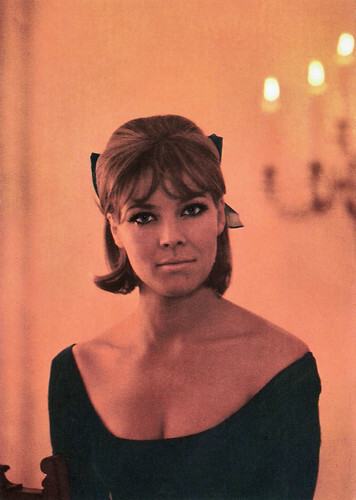
East-German postcard by VEB Progress Film-Vertrieb, Berlin, no. 2263, 1965. Photo: Schirmer.
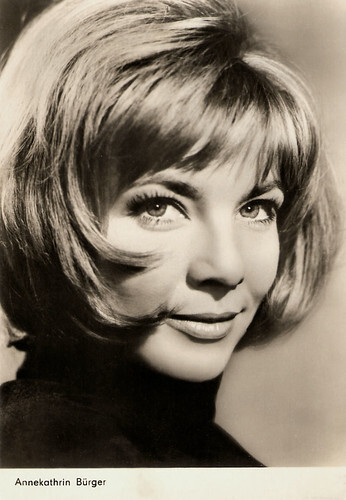
East-German postcard by VEB Progress Film-Vertrieb, Berlin, no. 2.313, 1965. Photo: DEFA / Bergmann.
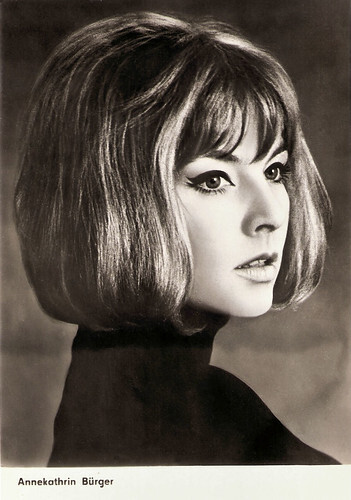
East-German postcard by VEB Progress Film-Vertrieb, Berlin, no. 2.606, 1966. Photo: Arno Fischer.
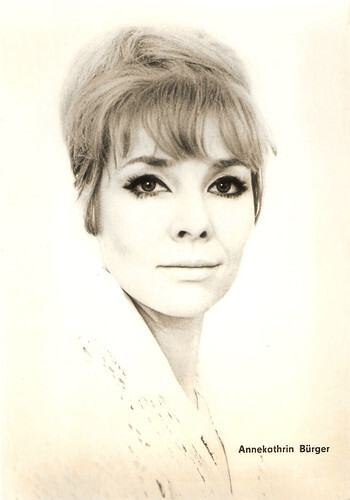
East-German postcard by VEB Progress Film-Vertrieb, Berlin, no. 57/69, 1969. Photo: Klaus D. Schwarz.
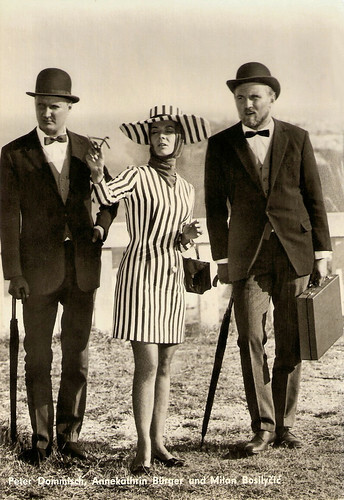
East-German postcard by VEB Progress Film-Vertrieb, Berlin, no. 80/69, 1969. Photo: Zähler / DEFA. Milan Beli (as Milan Bosiljcic) at right, Annekathrin Bürger and Peter Dommisch at left in Mit mir nicht, Madam!/Now ith me, Madam! (Roland Oehme, Lothar Warneke, 1969).
A more critical and realistic view of American expansion to the West
Annekathrin Bürger played numerous roles in DEFA and DFF films including the Ostern (Red Western) Tecumseh (Hans Kratzert, 1972) opposite Gojko Mitić and Rolf Römer.
It is part of a popular string of films starring the Yugoslav actor Gojko Mitić which, in line with the policies of Communist East Germany, attempted to present a more critical, but also more realistic, view of American expansion to the West than was characterised by Hollywood.
The film, along with others, was also made partly in response to the successful series of Karl May films made in West Germany. The film depicts the life of the Native American leader Tecumseh (1768–1813), including his role in Tecumseh's War and his later death in the War of 1812 while fighting with the British against the United States.
On television, she played a supporting role as a laundromat and bar manager in the popular series Tatort Leipzig with Peter Sodann, until 2005. She was also involved in cultural policy and protested against Wolf Biermann's expatriation and was committed to maintaining Charlotte von Mahlsdorf's Wilhelminian-style museum.
From 1990 to 1997 Bürger was chairman of the Congress of the National Citizens Movement. In 1993 she and her husband founded the orphans on the Don association. In the same year, the documentary film Children of the Don was made about it.
Annekathrin Bürger was first married to the actor and director Ulrich Thein and was married to her colleague Rolf Römer from 1966 until his death in 2000. Annekathrin Bürger lives in Berlin-Köpenick.
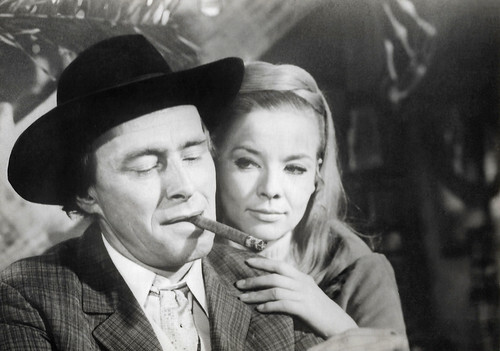
East-German postcard by VEB Progress Filmvertrieb, Berlin, no. 85/70e, 1970. Photo: DEFA / Blümel. Bruno O'ya and Annekathrin Bürger in Tödlicher Irrtum/Fatal Error (Konrad Petzold, 1970).
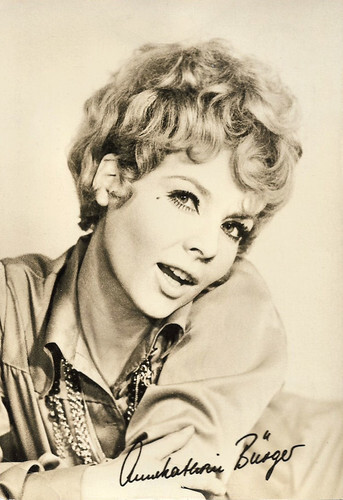
East-German postcard by VEB Progress Film-Vertrieb, Berlin, no. 131/70, 1970. Photo: Linke.
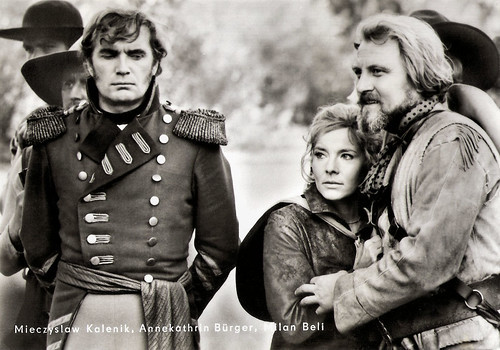
East-German postcard by VEB Progress Film-Vertrieb, Berlin, no. 50/72. Photo: DEFA / Zilmmer. Mieczyslaw Kalenik, Annekathrin Bürger and Milan Beli in Tecumseh (Hans Kratzert, 1972).
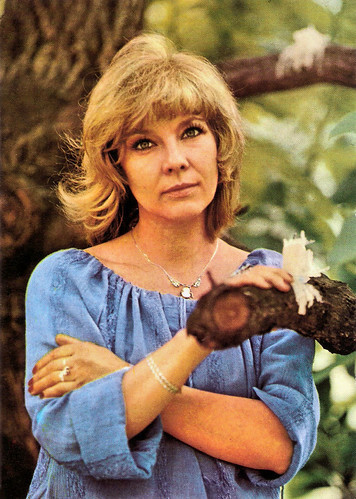
East-German postcard by Progress Film-Verleih, Berlin / Planet-Verlag, no. 10/F/78, 1978. Photo: Schwarz.
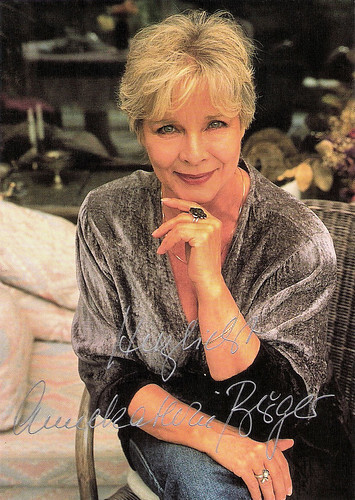
German autograph card.
Sources: Wikipedia (English and German), and .

East-German postcard by VEB Progress Film-Vertrieb, Berlin, no. 1901, 1963. Photo: Ludwig Schirmer.

East-German postcard by VEB Progress Film-Vertrieb, Berlin, no. 2569, 1966. Photo: Arno Fischer.

East-German postcard by VEB Progress Film-Vertrieb, Berlin, no. 3239, 1968. Photo: DEFA / Dietrich.

East-German postcard by VEB Progress Film-Vertrieb, Berlin, no. 9/72. Photo: Schütz. Annekathrin Bürger in Tecumseh (Hans Kratzert, 1972).
Unprecedentedly libertine in regards to sexuality
Annekathrin Bürger was born Annekathrin Rammelt in 1937 in Berlin-Charlottenburg, Nazi Germany. Her father was the animal draftsman and illustrator Heinz Rammelt.
She grew up in Hornhausen, trained as an advertising designer in Bernburg, and worked as a stage design assistant, prop master, and extra at the Carl-Maria-von-Weber-Theater there. She failed the entrance exam for the State Drama School in Berlin.
In the summer of 1955, she met Czech film people in Berlin and played her first small role as a pioneer leader in the Czech-German short film Gebirge und Meer/Mountains and sea (Wolfgang Bartsch, Bohumil Vosahlik, 1955).
A year later she appeared in the East German neo-realist romantic drama Eine Berliner Romanze/A Berlin Romance (Gerhard Klein, 1956), a film about youth urban life in the divided city of Berlin. It was produced by the DEFA, the state-owned East German studio. Annekathrin Bürger's co-stars were Ulrich Thein and Uwe-Jens Pape. It is still amongst DEFA's best-known films.
Bürger studied acting at the Potsdam Film and Television Academy from 1957 to 1960. From 1959 to 1960 she was engaged at the Deutsches Theater in Berlin. She also starred in another youth film, Reportage 57 (János Veiczi, 1959), and the romantic comedy Verwirrung der Liebe/Love's Confusion (Slátan Dudow, 1959), both with Willi Schrade. Love's Confusion was Dudow's last film and the screen debut of Angelica Domröse . Influenced by the relaxed political climate ushered with the Khrushchev Thaw, the picture was unprecedentedly libertine in regards to sexuality. It became a huge hit.

East-German postcard by VEB Progress Film-Vertrieb, Berlin, no. 639, 1958. Photo: Gerhard Puhlmann.

East-German postcard by VEB Progress Film-Vertrieb, Berlin, no. 710, 1958. Photo: Günther Ost.

East-German postcard by VEB Progress Film-Vertrieb, Berlin, no. 1.327 F, 1960. Photo: DEFA - Neufeld.

East-German postcard by VEB Progress Film-Vertrieb, Berlin, no. 2087, 1964. Photo: Ludwig Schirmer.

East-German postcard by VEB Progress Film-Vertrieb, Berlin, no. 2.253, 1965. Photo: DEFA / Schirmer.
The only DEFA film looking at Nazi Germany history in East Germany
During the early 1960s, Annekathrin Bürger appeared in a series of DEFA productions, such as Septemberliebe/September Love (Kurt Maetzig, 1961) with Doris Abesser and Ulrich Thein .
She also starred in the first joint Soviet–East German film, Pyat Dney, Pyat Nochei/Fünf Tage, Fünf Nächte/Five Days, Five Nights (Lev Arnshtam, Heinz Thiel, 1961) with Wilhelm Koch-Hooge.
The picture's plot was inspired by the recovery of the art of the Old Masters Picture Gallery through the hands of Soviet troops in 1945. The art collection was then taken to the USSR, where it was kept until being returned to the Dresden Gallery in 1960. Five Days, Five Nights sold more than two million tickets in the German Democratic Republic.
Then she starred in the romantic war drama Königskinder/Star-Crossed Lovers (Frank Beyer, 1962) with Armin Mueller-Stahl , and in the drama Das zweite Gleis/The Second Track (Joachim Kunert, 1962), as the daughter of Albert Hetterle. It is the only DEFA film looking at Nazi Germany history in East Germany.
From 1963 to 1965 Annekathrin Bürger was a member of the DFF, from 1965 to 2003 a member of the ensemble of the Volksbühne Berlin. Since 1968 she has only seldom been used in supporting roles in the theatre.

East-German postcard by VEB Progress Film-Vertrieb, Berlin, no. 2263, 1965. Photo: Schirmer.

East-German postcard by VEB Progress Film-Vertrieb, Berlin, no. 2.313, 1965. Photo: DEFA / Bergmann.

East-German postcard by VEB Progress Film-Vertrieb, Berlin, no. 2.606, 1966. Photo: Arno Fischer.

East-German postcard by VEB Progress Film-Vertrieb, Berlin, no. 57/69, 1969. Photo: Klaus D. Schwarz.

East-German postcard by VEB Progress Film-Vertrieb, Berlin, no. 80/69, 1969. Photo: Zähler / DEFA. Milan Beli (as Milan Bosiljcic) at right, Annekathrin Bürger and Peter Dommisch at left in Mit mir nicht, Madam!/Now ith me, Madam! (Roland Oehme, Lothar Warneke, 1969).
A more critical and realistic view of American expansion to the West
Annekathrin Bürger played numerous roles in DEFA and DFF films including the Ostern (Red Western) Tecumseh (Hans Kratzert, 1972) opposite Gojko Mitić and Rolf Römer.
It is part of a popular string of films starring the Yugoslav actor Gojko Mitić which, in line with the policies of Communist East Germany, attempted to present a more critical, but also more realistic, view of American expansion to the West than was characterised by Hollywood.
The film, along with others, was also made partly in response to the successful series of Karl May films made in West Germany. The film depicts the life of the Native American leader Tecumseh (1768–1813), including his role in Tecumseh's War and his later death in the War of 1812 while fighting with the British against the United States.
On television, she played a supporting role as a laundromat and bar manager in the popular series Tatort Leipzig with Peter Sodann, until 2005. She was also involved in cultural policy and protested against Wolf Biermann's expatriation and was committed to maintaining Charlotte von Mahlsdorf's Wilhelminian-style museum.
From 1990 to 1997 Bürger was chairman of the Congress of the National Citizens Movement. In 1993 she and her husband founded the orphans on the Don association. In the same year, the documentary film Children of the Don was made about it.
Annekathrin Bürger was first married to the actor and director Ulrich Thein and was married to her colleague Rolf Römer from 1966 until his death in 2000. Annekathrin Bürger lives in Berlin-Köpenick.

East-German postcard by VEB Progress Filmvertrieb, Berlin, no. 85/70e, 1970. Photo: DEFA / Blümel. Bruno O'ya and Annekathrin Bürger in Tödlicher Irrtum/Fatal Error (Konrad Petzold, 1970).

East-German postcard by VEB Progress Film-Vertrieb, Berlin, no. 131/70, 1970. Photo: Linke.

East-German postcard by VEB Progress Film-Vertrieb, Berlin, no. 50/72. Photo: DEFA / Zilmmer. Mieczyslaw Kalenik, Annekathrin Bürger and Milan Beli in Tecumseh (Hans Kratzert, 1972).

East-German postcard by Progress Film-Verleih, Berlin / Planet-Verlag, no. 10/F/78, 1978. Photo: Schwarz.

German autograph card.
Sources: Wikipedia (English and German), and .
Published on October 18, 2021 22:00
Paul van Yperen's Blog
- Paul van Yperen's profile
- 13 followers
Paul van Yperen isn't a Goodreads Author
(yet),
but they
do have a blog,
so here are some recent posts imported from
their feed.



